Archive for the ‘Wildlife’ Category
Tuesday, September 13th, 2011
The following letter to the editor appeared in the Blue Mountains Gazette newspaper on page 12 of 10th August 2011, written by Rose and Brett Everingham of Lapstone, Blue Mountains, Australia.

‘Native Wildlife Alert’
.
‘On the evening of Tuesday July 29 a beautiful Echidna was unfortunately hit by a car outside our house.
We would like to publicly thank the three lovely young gentlemen who stopped to assist us as we moved it off the road, and then rang WIRES.
It was a particularly upsetting experience, no one wants to see any creature hit by a car, especially our native wildlife. The young gentleman who hit the Echidna was understandably distressed, as it is not something you would usually expect to see, and we reassured him that it was simply an accident.
It is a timely reminder though to take care when driving at night, particularly on Governors Drive which is often used as a race track for some drivers. Unfortunately the Echidna could not be saved. Once again a thanks to the young gentleman who stayed with my husband and son whilst they buried it.
Whilst a sad experience, it brought relief to know that Lapstone still has such beautiful native wildlife existing amongst us in the bush.’
.
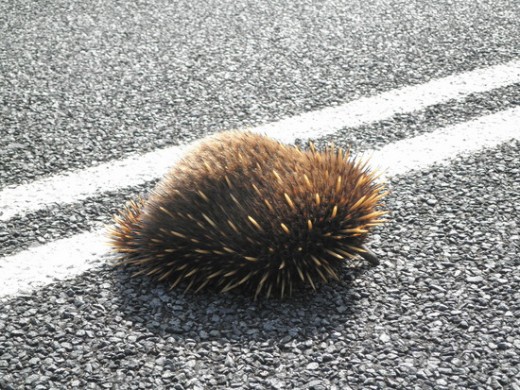
.
.
Editor’s Comments:
.
1. The killing of a native echidna by a driver of a car is an horrific tragedy for the echidna and its likely dependent mate and offspring, which were not mentioned. Each killing of adult native wildlife harms the viability of the local population of that species in the area.
2. Rose and Brett are right to have done what they did and it is valuable to the local community that Rose has taken the trouble to share this tragic event via her letter in the local paper.
3. The cause of the Echidna’s death was that the car driver was driving too fast to prevent killing it on the road. Most drivers drive too fast and are not competently trained to drive for the conditions.
It could have been a child killed while running on to the road. I am sure the local paper would have had more than allowing Rose’s letter, which reflects our culture that human life holds selfishly somehow higher values than wildlife. One may call this ‘speciesism’, a term few are aware.
4. Echidna habitat was there many thousands of years before European colonists destroyed its environment and selfishly carved a road through its habitat, with no care for any native wildlife values.
5. Such roads as Governors Drive, whether constructed by local Blue Mountains Council or larger ones by the Roads and Traffic Authority (RTA), not only destroy native vegetation and wildlife habitat in their construction, as well as allowing sediment pollution of downhill watercourses; no respect is paid to the inevitable road death consequences caused by vehicles using the road. The underlying reason is that human values for wildlife are so low across the community that there is hardly any call for wildlife protection from the threats of road making and its consequential traffic menace. Worse is that perverted attitudes toward wildlife and deviant behaviour prevail to the extent that the killing of wildlife on our roads is disparagingly dismissed as ‘roadkill’. If the same term were applied to pedestrian deaths on our roads, there would be an uproar by extreme humanists.
6. No attempt is made by road builders (local council or the RTA) to facilitate separation of ground dwelling native wildlife from the inevitable risk of death from introduced road traffic. Some roads across Australia have wildlife fencing to prevent native animals such as wallabies, wombat and Echidnas from accessing the road. Others factor wildlife corridors into the design of roads that destroy wildlife habitat. It is an indictment on both the Blue Mountains Council and the RTA that there are no wildlife fences or wildlife corridors throughout the Blue Mountains.

7. That Rose wrote “it is not something you would usually expect to see” is a sad indictment on the demise of wildlife populations across the Blue Mountains since colonial conquest, such that now people living in the Blue Mountains do not expect to see wildlife any longer. Villages like Lapstone have become so urbanised that they are all but outer suburbs of Sydney. The natural bush environment has been lost to a sterile parkland to suit the needs of humans. The values of native wildlife and their habitat continue to be ignored by humans who live and drive through the Blue Mountains and by custodial government authorities – Blue Mountains Council, NSW Department of Environment (etc), Australian Department of Environment (etc).
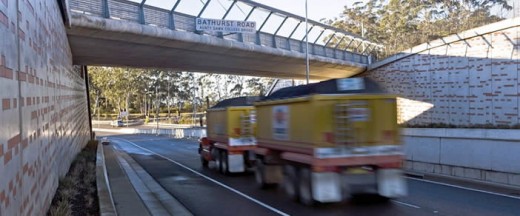 . .
Yet, despite the arrogant disregard for wildlife values across the Blue Mountains, especially at the human interface, other regions take a more proactive view, such as in Sydney’s Northern Beaches region.
.
 Uncontrolled speeding on Australian roads Uncontrolled speeding on Australian roads
.
Related Articles:
.
‘Wallaby becomes roadkill after fence holed’
.
by Brenton Cherry, 20110112, Many Daily, ^http://manly-daily.whereilive.com.au/news/story/wallaby-becomes-roadkill-after-fence-holed/
 Eira Battaglia, Mandy Beaumont, Niamh Kenny,
Cassie Thompson and Elvira Lanham at the damaged fence.
(Photo by Virginia Young) Eira Battaglia, Mandy Beaumont, Niamh Kenny,
Cassie Thompson and Elvira Lanham at the damaged fence.
(Photo by Virginia Young)
.
‘A hole has been cut in the wildlife-proof fence along Wakehurst Parkway at Oxford Falls, leading to at least one wallaby being killed. The death – discovered by Jacqui Marlow from the Northern Beaches Roadkill Prevention Group – was the first along the stretch of road since the fence was installed.
“Why would anyone cut a hole in the fence?” she said. “I found the hole after seeing a dead wallaby in the fence area.
“It’s the first one killed in the fence area since it was installed, which shows that it works.”
Ms Marlow said she had become disenchanted by the actions of some people.
“At the moment my opinion of humans is not very good, especially when it comes to their attitude to nature,” she said. “I’m really tired of dealing with it, the deaths are starting to get me down.”
Fellow group member Eira Battaglia said now more than ever motorists had to be aware of wildlife on our roads.
“Wallabies are around after the recent burn-off,” she said.
“Eight have been killed in the past week so please drive carefully, especially at dusk when the wallabies may be out searching for food.”
A spokesman for the RTA said a maintenance crew would permanently fix the hole as soon as possible. “A temporary repair has already been carried out,” he said.
RTA representatives yesterday met with the roadkill prevention group for a tour of local hot spots and potential sites for additional fauna fencing.’
.
.
‘Peering down the corridor’
.
Source: ^http://www.coolmelbourne.org/articles/2009/07/peering-down-the-corridor/
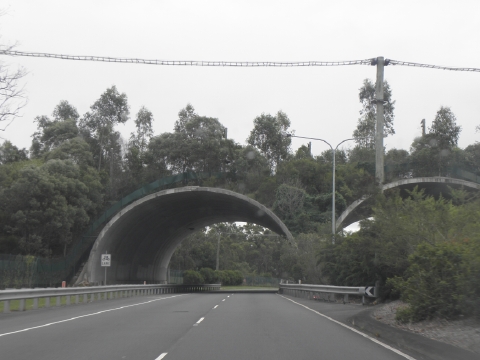 Wildlife Corridors do exist and are effective where human communities
care enough to insist on them.
But don’t expect road designers and engineers in Australia to suggest the concept. Wildlife Corridors do exist and are effective where human communities
care enough to insist on them.
But don’t expect road designers and engineers in Australia to suggest the concept.
.
.
‘Conservationists have long recognised the value of using wildlife corridors to connect wilderness areas, and there is mounting evidence to show that these corridors help many species, from the big to the small to the airborne to the aquatic.
But now ‘megacorridors’ are taking the wildlife corridor concept to a whole new level. Australia’s Great Eastern Ranges Initiative (GERI) is Australia’s answer to the megacorridor.
Aiming to create a 2800km wilderness megacorridor from North Queensland to Victoria, the initiative is about halfway towards completion of the first and most critical stage.saving-wilderness-geri-map-new-scientist.jpg
It is an extremely important move in the conservation of Australia’s biodiversity: after more than 200 years of development, the landscape of eastern Australia has changed significantly.
Fences, roads, dams, industrial and agricultural lands, powerlines, towns and cities cut across the country, isolating natural areas which have become ‘islands’ on which plants and animals have become isolated.
This means that many ecosystems have been fragmented, that the landscape’s capacity to maintain our unique plants, animals and Aboriginal cultural heritage has been reduced. It also means that remaining ecosystems are finding it harder to filter and clean our air, maintain the health of our soils, and produce unpolluted fresh water for the 93% of the Australian population that lives along Australia’s eastern seaboard.
This is no quick fix project however: climate change and the migration of human populations means it could take as long as 100 years before the project’s success can be measured.’
.
.
‘Wildlife corridor from far south to far north’
.
by Mat Churchill, 20100716, ^ http://www.tourismportdouglas.com.au/Wildlife-corridor-from-far-south-to-far.4317.0.html
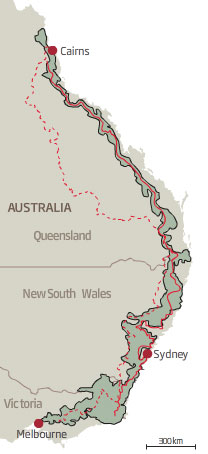
The Great Eastern Ranges Initiative, a proposed 2,800km long conservation corridor
Patches of state and national parks around the country just aren’t sufficient to protect Australia’s native plants and animals.
According to a report commissioned by the NSW Department of Environment, Climate Change and Water, a wildlife corridor 2,800km long stretching from Melbourne to the Atherton Tablelands would allow species to migrate when their habitat changes due to climate change.
”One of the impacts of climate change is that species will have to move around to find suitable habitat resources. We need to make the whole landscape more biodiversity friendly.” said Brendan Mackey, an environmental scientist who wrote the report.
Dubbed the Great Eastern Ranges Initiative, the corridor would be made up of public and privately owned land.
Ian Pulsford, from the Department of Climate Change and Water, said areas earmarked to become part of the corridor would see a person acting as a broker visit the private landholder to discuss the program.
”The corridor is voluntary but there has been a good response from private landholders, and there are incentives to make your land part of the conservation area,” said Mr Pulsford.
The corridor concept is a new way of thinking when it comes to conservation. And a change in the way we do things in Australia is clearly needed when nearly half of the world’s mammal extinctions in the last 200 years have happened here, along with 61 species of flowering plants among others. The world’s current extinction rate is 1,000 higher than nature intended.
”The conventional thinking is wait until things are really bad and then desperately try to save things at the last minute,” said Professor Mackey.
.
.
Further Reading:
.
[1] ^http://www.coolmelbourne.org/our-environment/wildlife/
.
– end of article –
Saturday, September 3rd, 2011
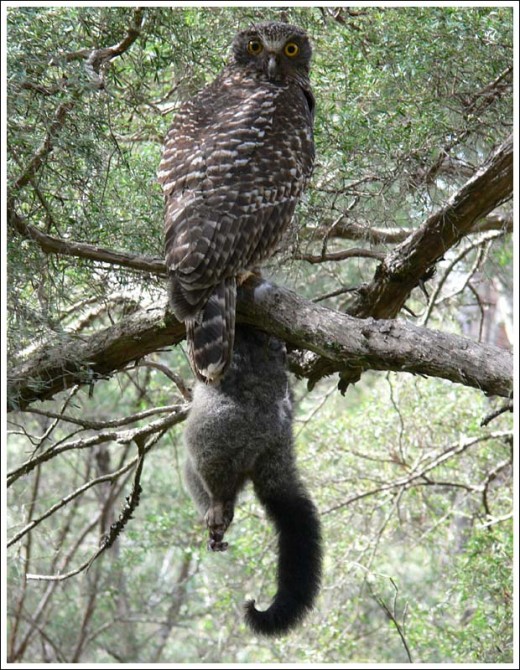 Australia’s native Powerful Owl with native prey – a juvenile Brushtail Possum (2kg?) Australia’s native Powerful Owl with native prey – a juvenile Brushtail Possum (2kg?)
© Photo by Duncan Fraser
^http://www.natureofgippsland.org/
.
Powerful Owl Call
(turn on your computer volume)

.
.
Drought, bushfires…it’ll take years to find out what’s happened to Victoria’s Forest Owls
.
[Source: ‘Something is knocking the states owls off their perches‘, by John Elder, The Age newspaper (Victoria, Australia), 20100613, ^http://www.theage.com.au/victoria/something-is-knocking-the-states-owls-off-their-perches-20100612-y4s0.html]
.
‘What’s happened to Victoria’s carnivorous owls? A significant number have vanished, and the (Victorian) Department of Sustainability and Environment (DSE) isn’t sure what’s going on.
It’s assumed the top end of the woodland food chain is either starving to death because its food source has been killed off by the drought and fires, or it is relocating to parts unknown, but it will take years to find an answer.
The DSE has been monitoring the owl populations – including that of the Powerful Owl, Australia’s largest owl – since 2000. Since then, detection rates in South Gippsland and the Bunyip State Park have dropped by half.
In some areas of the Bunyip State Park – half of which was lost to the Black Saturday fires – detections of the Sooty Owl have dropped to a third.
DSE owl specialist Ed McNabb says: ”We don’t know what’s happened to them. We can only assume that drought has played a major role. We noticed the downward trend before the fires. They’re very mobile birds, but the fires would have had an impact on their prey.”
Powerful and sooty owls, both officially listed as vulnerable, mainly eat sugar gliders and ringtail possums. The possums in particular are known to have little resistance to chronic hot weather, and their failure to thrive in the drought is the main reason why owl numbers have dropped.
While owls may have escaped (Victoria’s) Black Saturday fires, many possums would have been incinerated.
.
McNabb says the smaller carnivorous birds, such as the barking owl, are able to sustain themselves on insects. Powerful and sooty owls can also eat rabbits and birds such as magpies and kookaburras, but they need to make the change in their diet before energy loss reduces their ability to effectively hunt.
”They’ll either starve or take something else,” said McNabb.
Equally disastrous for the owls was the loss of old trees with large hollows that they require for nesting. They might have shifted elsewhere to recolonise, but this would mean taking over an already occupied territory. ”And there tends to be a home-ground advantage in these battles,” said Mr McNabb. The occupying bird has inside knowledge of the territory and a greater capacity to defend its patch, because it’s energy store will be higher. Flying great distances in search of food saps the strength from large birds and even causes them to starve.
The DSE’s biodiversity team leader for West Gippsland, Dr Rolf Willig, said:
The top order carnivores were ”an indicator species as to the well-being of the ecosystem.
Theoretically, if they’re happy, the rest are happy.”
.
For five years Dr Willig has been running a playback monitoring program in South Gippsland, where recordings of owl calls are played into the dark and answering calls are recorded. The number of birds answering calls have dropped significantly this year.
”The results indicate we may be having a delayed reaction from the fires,” he said. ”The possums not actually killed in the fires might have been exposed afterward, and the owls picked them off, eating all the food that was left.”
It will take years to find out what’s happened. ”And not just three or five years. We’ll be out here for a long time,” said Dr Willig.’
.
.
‘Conservation through Knowledge’ – a motto of leadership

The Royal Australasian Ornithologists Union is Australia’s largest non-government, non-profit, bird conservation organisation. It has sensibly branded itself as ‘Birds Australia‘, which in just two words says all that it is about, and the Emu family graphic is uniquely representative of Australia ~ the Emu being Australia’s largest bird.
Similarly sensible is its motto ‘Conservation through knowledge‘ which provides inspiration for conservation leadership, beyond Ornithology. The organisation was founded way back in 1901 to promote the study and conservation of the native bird species of Australia and adjacent regions, making it Australia’s oldest national birding association.
The Powerful Owl call above is sourced courtesy of Birds Australia.
.
.
Powerful Owl (Ninox strenua)
http://www.birdsaustralia.com.au/our-projects/powerful-owl-wbc.html
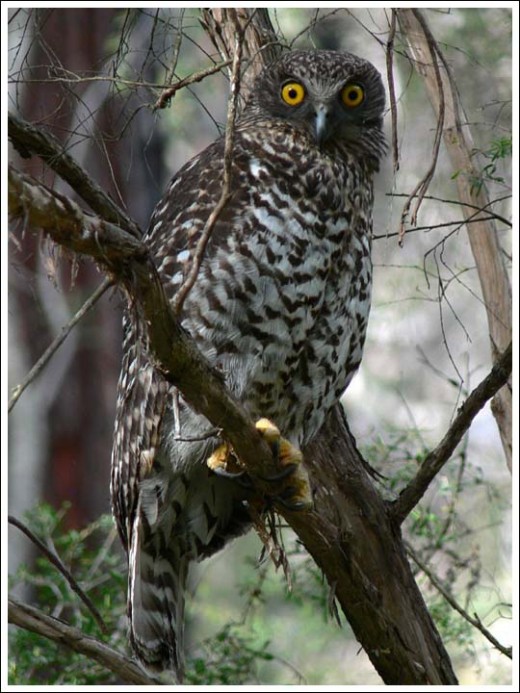 Powerful Owl (weighs under 1.5 kg) Powerful Owl (weighs under 1.5 kg)
© Photo by Duncan Fraser
^http://www.natureofgippsland.org/
.
A noctural top-order predator of tall old forests, the Powerful Owl is territorial, sedentary and monogamous ~ it calls one place home and mates for life (a lifestyle model for many humans).
.
HABITAT
Throughout most of its range this species typically inhabits open and tall wet sclerophyll forest, mainly in sheltered, densely vegetated gullies containing old-growth forest (where they breed in hollows in large trees) with a dense understorey, often near permanent streams. Such habitats are often dominated by Mountain Grey Gum, Mountain Ash, Manna Gum or Narrow-leafed Peppermint. They occasionally also occur in rainforest in gullies surrounded by sclerophyll forest or woodland. Powerful Owls also occur in adjacent open dry sclerophyll forests and woodlands, such as those dominated by box–ironbark eucalypts, Candlebark, Messmate or riparian River Red Gums; they sometimes also occur in open casuarina and cypress-pine forests.
The main food source for these owl species is hollow-dependant mammals (e.g. greater gliders, sugar gliders). Natural processes that create tree hollows typically take hundreds of years to form.
Human disturbed forests, through logging/burning/fragmentation/euphemistic ‘clearing’, destroy these vital yet rare hollow-bearing trees, and this considerably disadvantages owls.
DISTRIBUTION
- Endemic (found nowhere else on the planet, except for…) to eastern and south-eastern mainland Australia, mainly on the seaward side of the Great Divide.
.
CONSERVATION STATUS
- Vulnerable in Queensland
- Vulnerable in New South Wales
- Vulnerable in Victoria
- Endangered in South Australia
.
SURVIVAL THREATS
- Powerful Owls are adversely affected by the clearfelling of forests and the consequent conversion of those forests into open landscapes. [Deforestation]
.
When in flight, the silhouette of the Powerful Owl is distinctive, combining long, broad, rounded and deeply fingered wings with a large, sturdy body and a longish tail, gently rounded at the tip when spread. The flight is rather slow, with deep laboured wing-beats interspersed with glides.
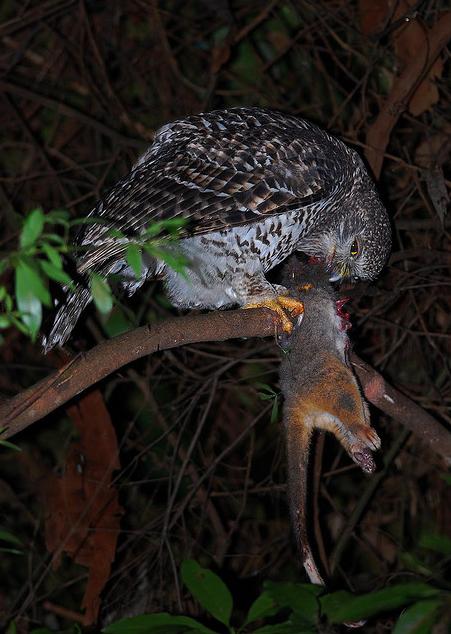
.
.
References and Further Reading:
.
[1] The Nature of Gippsland (photographic website), ‘A photo gallery featuring the natural world of Gippsland, Victoria, Australia’, Photographs by Duncan Fraser, ^ http://www.natureofgippsland.org/
[2] Birds Australia, (Special survey on Powerful Owl distribution around Sydney, 2011), ^ http://birdsinbackyards.net/surveys/powerful-owl.cfm
[3] ‘ Powerful Owl (Conservation) Action Statement, Victorian Government, Department of Sustainability and Environment, (1999), ^ http://www.dse.vic.gov.au/__data/assets/pdf_file/0019/103177/092_powerful_owl_1999.pdf [ Read More]
[4] ‘ Protecting Victoria’s Powerful Owls‘, Victorian Government, Department of Sustainability and Environment, (2001), ^ http://www.dse.vic.gov.au/__data/assets/pdf_file/0012/102144/PowerfulOwls.pdf [ Read More]
.
– end of article –
Tags: Birds Australia, Conservation through Knowledge, Forest Owls, hollow-bearing trees, old growth, Otway Ranges, Powerful Owl, Sooty Owl, South Gippsland
Posted in 07 Habitat Conservation!, Gippsland (AU), Otway Ranges (AU), Owls, Threats from Bushfire, Threats from Deforestation | No Comments »
Add this post to Del.icio.us - Digg
Friday, September 2nd, 2011
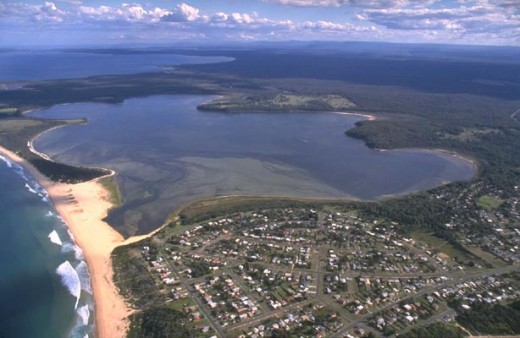 Lake Wollumboola,
South Coast (Shoalhaven Region) of New South Wales, Australia Lake Wollumboola,
South Coast (Shoalhaven Region) of New South Wales, Australia
.
Where is NSW Premier Barry O’Farrell’s environment minister when you need her?
.
Where is NSW Minister for Environment (etc.) Robyn Parker when it comes to a land use development threat to coastal breeding grounds of migratory birds and to a nominated Ramsar Wetland?
Lake Wollumboola is a natural shallow, saline, coastal lagoon, located on the NSW south coast lies north juxtaposed to Jervis Bay and forms an integral part of the Jervis Bay National Park. Lake Wollumboola is listed as a wetland of national importance, and the NSW Office of Environment and Heritage is investigating its nomination as a wetland of international importance under the Ramsar Convention on Wetlands.
Lake Wollumboola supports abundant growth of sea grass and algae, and is currently home to several thousand black swans and grey and chestnut teals and ten threatened species of Australian fauna. International migratory birds depend upon Lake Wollumboola during seasonal migration including the Caspian Tern and Little Tern.
 Little Tern (Sterna albifrons) with its distinctive black crest
[Source: ^http://www.ozanimals.com/Bird/Little-Tern/Sterna/albifrons.html] Little Tern (Sterna albifrons) with its distinctive black crest
[Source: ^http://www.ozanimals.com/Bird/Little-Tern/Sterna/albifrons.html]
.
NSW Minister for Environment etc Robyn Parker may have come to politics with the credo of ‘keeping it real’, but what environmental conservation credibility does Robyn Parker have? Many conservations are trying to keep Lake Wollumboola real and indeed free from a new golf course development threat on its northern shores.
Parker’s claim to fame is in teaching, community services, child care, childhood education, early intervention, and health issues such as drug rehabilitation and education. But sorry Adrian Piccoli MP got the Ministry for Education. So why did O’Farrell gift her with the important and controversial ‘Environment’ portfolio? No-one else put their hand up? What personal interest does Robyn Parker have in Environmental Conservation? NSW Environment Minister Robyn Parker has probably never heard of Lake Wollumboola. Has she?
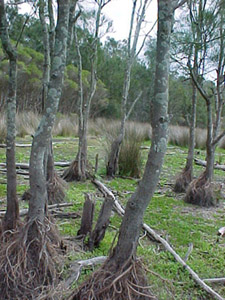
.
.
.
20th Century Golf Course Development Threat to Lake Wollumboola
.
According to the Sydney Morning Herald 20110827, defenders of Wollumboola are worried about a proposal for an 18-hole golf course on the lake’s north-western shore lodged with Shoalhaven City Council by the developer Allen, Price and Associates on behalf of the landowner, Warren Halloran. Halloran is bleating the standard ‘jobs, jobs, jobs‘ and ‘good for tourism‘ justifications for his planned development. But seriously it is just about profiting from exploitative development of natural land without a care to the ecological impact. The development concept is backward 20th Century, who the hell plays golf in the 21st Century? Golf clubs are in crisis around the nation trying to find new members. Their existing membership base of baby boomers are dying of old age!
A development application for the course lodged with the council on June 30 has attracted more than 60 submissions, nearly three-quarters opposed. Review of the proposal by local Shoalhaven Council is likely taking place behind closed doors as a ‘Confidential Business Paper‘ ~ which translates into ‘democracy exempt‘.
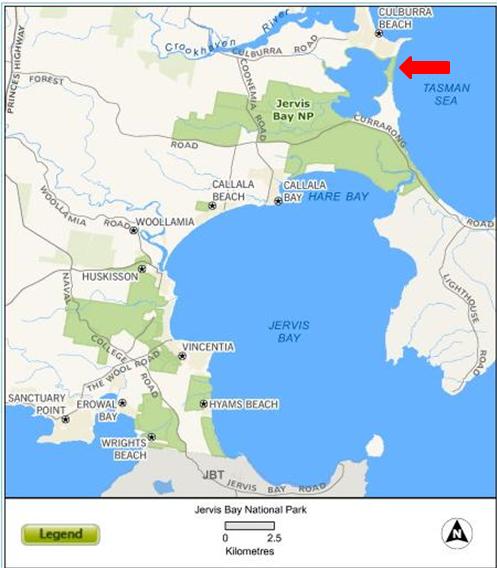
.
Council Decision on RAMSAR Wetlands?
.
The president of the Lake Wollumboola Protection Association, Frances Bray, said one of the biggest dangers from a golf course would be increased runoff of organic material and fertilisers.
It is feared that algal blooms could choke the lake, killing the fish, crustaceans and seagrass that can attract up to 20,000 birds during drought.
”It’s just the most beautiful serene place and to think that that could be degraded for a golf course is an absolute tragedy,” Ms Bray said.
A water management plan submitted with the development application proposed the construction of wetlands to treat stormwater runoff from the site, but the plan acknowledged that not all of the fairway areas would be covered.
The Greens councillor Amanda Findley, said the proposal was a last-minute attempt to develop land set down to become conservation land under proposed new land zoning.
But the proposed golf course has garnered some support from nearby Culburra Beach for employment opportunities and increased tourism.
The council will hold a public meeting on Monday.’
.
[Source: ‘Water hazard: golf plans at prized lake ruffle conservationists’ feathers’, Peter Rae, 20110827, Illawarra Mercury,^http://www.illawarramercury.com.au/news/national/national/environment/water-hazard-golf-plans-at-prized-lake-ruffle-conservationists-feathers/2272184.aspx, accessed 20110828]
 Jervis Bay Heathland near Lake Wollumboola
(© Photo by Michael Thompson) Jervis Bay Heathland near Lake Wollumboola
(© Photo by Michael Thompson)
.
.
Lake Wollumboola?
.
The Shoalhaven landscape is home to some of the outstanding natural features of the South Coast of NSW. The landscape contains wetlands of national importance, significant habitat for international migratory species, and is a habitat stronghold for the threatened Green and Golden Bell Frog.
The scenic beauty of the lower Shoalhaven and the lifestyle of coastal and estuary villages attract large numbers of visitors to the area. Important Aboriginal places around the estuary, coastal floodplain and headlands reflect a cultural attachment to the estuary’s natural resources extending over thousands of years. The Shoalhaven region includes a number of sensitive natural assets. The Shoalhaven River and estuary system, Jervis Bay, Coomondary Swamp and Lake Wollumboola and a number of other coastal lakes and estuaries all represent sensitive natural environments.
.
Lake Wollumboola
Lake Wollumboola and is a coastal estuarine lake within the Shoalhaven region situated south of Culburra Beach, between the Shoalhaven River and Jervis Bay and the Beecroft Peninsula. The Lake, sand bar and south west part of the catchment are included in the Jervis Bay National Park. It has an area catchment of 35 km2, and a waterway area of 6.2 km2. Lake Wollumboola is situated between Culburra Beach (north) and Currarong Road (south) at the northern end of the Beecroft Peninsula. Coonemia Creek flows into Lake Wollumboola. This estuary falls in the area covered by Southern Rivers Catchment Management Authority.
The lake does not possess an inlet channel – after periods of sufficient rainfall, the lake breaches directly across Warrain Beach to form the entrance.
Lake Wollumboola is recognised for its conservation attributes, and in 2002 was included in the Jervis Bay National Park. The Lake is frequented by thousands of native black swans, ducks, herons and waders, especially as a wetland refuge in times of drought. Large numbers of migratory birds visit the lake including over twenty species protected by international treaties.
‘Protected (endangered) species such as the Little Tern and Green and Golden Bell frog breed on the foreshores of the lake.’
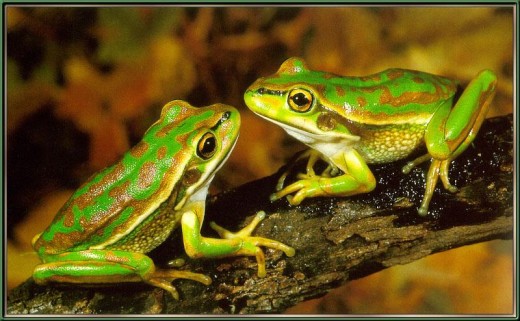
Endangered Green and Gold Bell Frogs (Litoria aurea)
.
Lake Wollumboola possesses over a square kilometre of seagrass meadows, which provide vital habitat and food sources for the many migratory bird species that seasonally visit the lake. The endangered species Wilsonia rotundifolia is also present.
The woodlands, white sands and translucent waters of Jervis Bay are reminiscent of an early, pristine environment. This park has many facets – woodland and heath, wetland and lake, seagrass beds, bays and beaches. Together they create a place that is especially beautiful. The unique Lake Wollumboola is an integral part of the park with the lake, its foreshores, associated wetlands, creeks and springs interlocking to produce twelve rich waterbird habitats in a relatively small area.
Aboriginal heritage goes back many thousands of years here and local Aboriginal people continue to maintain strong links with places special to them.
Shoalhaven City Council formed the Lake Wollumboola Estuary Management Task Force to prepare the Lake Wollumboola Estuary Management Plan.
With gazetting of the lake as part of the Jervis Bay National Park the Lake Wollumboola Reference Group was established by Department of Environment and Conservation (DEC) to oversee preparation of the Lake Wollumboola component of the Jervis Bay National Park Plan of Management.. The NSW Government is preparing a Sustainability Assessment for Lake Wollumboola, as recommended by the Healthy Rivers Commission Inquiry into Coastal Lakes.
But high human population growth rates in the Shoalhaven places considerable pressure on these natural resources, highlighting the need for appropriate management and investment.
.
Wetlands Under Threat
.
‘Wetlands are among the most threatened ecosystems in the world.
In the past, many wetlands were drained or filled in to create farmland or urban areas. In NSW, regional wetland losses range from 40% to 80% since European settlement. Although no longer openly destroyed, wetlands are currently affected by alteration of natural flow patterns caused either by droughts or by water extraction and regulation of rivers by building dams and weirs. Urban development, land clearing, grazing and use of pesticides can also impact adversely on water quality and the natural water cycles of wetlands.
Another threat to wetlands, and other ecosystems, is climate change. In inland NSW, climate change is expected to modify rainfall, evaporation and flooding patterns, increase droughts and bushfires, change the temperature of water bodies and, along the coast, cause sea levels to rise. This threat will cause the coastline to retreat and saltwater to flood freshwater lakes and lagoons.’
.
[Sources: ^ http://www.environment.nsw.gov.au/nationalparks/parkhome.aspx?id=N0090,
NSW Department of Natural Resources, ^http://test.dnr.nsw.gov.au/estuaries/inventory/wollumboola.shtml
Southern Rivers Catchment Management Authority, ^http://www.southern.cma.nsw.gov.au/our_catchment-shoalhaven.php
NSW Government Land and Property Information , Atlas of NSW – Wetlands, ^http://www.atlas.nsw.gov.au/public/nsw/home/topic/article/wetlands.html]
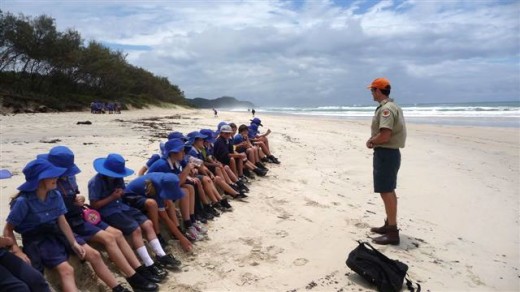
.
.
‘International recognition due to Lake Wollumboola on World Wetlands Day’
.
[Source: Nature Conservation Coucnil of NSW, 20080201, ^http://www.nccnsw.org.au/media/international-recognition-due-lake-wollumboola-world-wetlands-day]
.
The state’s peak environment group has called for the protection of Lake Wollumboola near Culburra Beach on the eve of World Wetlands Day on Saturday 2nd February.
“The Nature Conservation Council calls on the NSW Government to celebrate the unique beauty of Lake Wollumboola this World Wetlands Day and protect it under a Ramsar listing,” Cate Faehrmann, executive director of the Nature Conservation Council said today.
“Lake Wollumboola more than meets the criteria to be protected by an international Ramsar listing.
“Lake Wollumboola is a fragile and unique place that provides a safe haven for many endangered plants and animals like the Little Tern and the Green and Golden Bell Frog.
“Of the nine possible criteria for being protected under the international Ramsar listing, Lake Wollumboola meets five. Only one of these conditions needs to be met to make the area eligible for protection.
“A Ramsar listing for the lake would allow low impact recreational activities to continue, and encourage international nature and Aboriginal cultural heritage tourism and environmental education activities.
“Lake Wollumboola is one of the largest shallow saltwater lake in New South Wales. It often provides a home for thousands of iconic water birds and waders like Swans, Chestnut Teal and Bar tailed Godwits.
“The lake supports at least 43 species of migratory birds large populations of local species, with bird populations estimated at over 20,000,” Ms Faehrmann said.
.
.
During 2001/2 Researchers have been studying the complex processes of Lake Wollumboola, including the presence of Hydrogen Sulfide in the sediments and water column, and the age and rate of deposition of the sediments.
Shoalhaven City Council through its Lake Wollumboola Estuary Management Task Force developed a Community Education strategy for Culburra Beach. This focuses primarily on the Hydrogen Sulfide issue. The National Parks and Wildlife Service is likely to proceed with this program.
.
[Source: http://www.wollumboola.org.au/]
.
.
‘Lake Wollumboola gazetted as part of the Jervis Bay National Park’
.[Source: http://www.wollumboola.org.au/news.php]
.
On 11th December (1997), the Attorney General and Minister for the Environment, Mr. Bob Debus announced his decision to gazette the bed of Lake Wollumboola, the sand bar and surrounding crown land as part of the Jervis Bay National Park. Mr. Debus said the lake is one of the most significant water habitats in the State. “in recent years we have been fortunate to witness an extraordinary natural phenomena on Lake Wollumboola when 20,000 waterbirds at a time gather to feed on the lake’s rich food source.”.
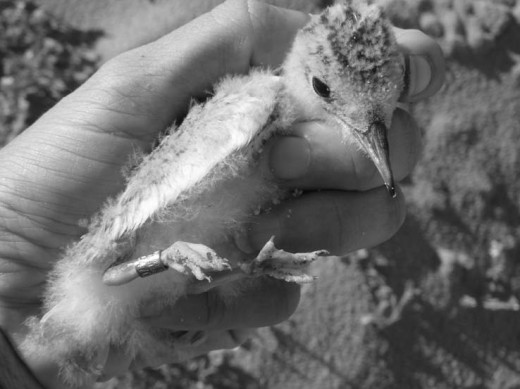 Little Tern chicks at Lake Wollumboola, 2008
(click photo to enlarge) Little Tern chicks at Lake Wollumboola, 2008
(click photo to enlarge)
.
.
.
‘The saviours of Lake Wollumboola’
[Source: Penny Figgis (ACF Vice President and a board member of the Environment Protection Authority of NSW) and Bruce Donald (Sydney lawyer and consultant, and gave voluntary legal advice to the campaign).
© 2000 Australian Conservation Foundation, © 2008 Gale, Cengage Learning, ^http://findarticles.com/p/articles/mi_hb4727/is_4_28/ai_n28789147/
.
In 2008, local conservationists, Frances Bray and Keith Campbell, were celebrated as winners of the Australian Conservation Foundation’s Peter Rawlinson Conservation Award.
‘For more than seven years Frances and Keith, together with many dedicated people in the Lake Wollumboola Support Group, tirelessly fought against a huge subdivision of some 3000 houses that would have unquestionably damaged the unique ecology of the lake and its surrounding forest.
Lake Wollumboola is one of the New South Wales coastline’s last remaining, virtually pristine, coastal lakes that intermittently open and close to the sea. It lies at Culburra Beach between the mouth of the Shoalhaven River and Jervis Bay. The lake is on the Register of the National Estate, is a wetland of key significance and a habitat for resident and migratory birds of international importance. Several threatened species have been identified within the area, including the green and gold bell frog which is seasonally abundant in the grassy edges of the lake.
For most of the past century the land around the lake was within the paper subdivision plans of the only major developer of the Shoalhaven, Realty Realizations. In the early 1990s the company finally achieved a rezoning of the land by the Shoalhaven City Council and the government of the day. The subdivision carried with it the threat of serious pollution from urban run-off, loss of forested habitat and increased recreational pressures, including demands to prevent the lake’s natural cycle of periodic draining.’
.
In for the long haul
‘Although the politics and regional power dynamics were against them and government departments were equivocating, Frances Bray and Keith Campbell refused to consider the battle lost. Together with the Lake Wollumboola Support Group, they mobilised all the effort needed to begin the task. Their dogged campaign finally achieved a decision in 1995 by the Minister for Urban Affairs and Planning to remove from the council its ability to approve the subdivision. Then, in 1996, a Commission of Inquiry into the subdivision was appointed.
At this point Frances and Keith enlisted some voluntary legal back-up and achieved a historic grant of legal aid for the inquiry from the New South Wales Legal Aid Commission. Though small, this grant helped obtain high calibre water, fauna, vegetation and social impact reports from acknowledged experts to give independent substance to their case. This also contributed to a reversal by National Parks and Wildlife Service on the first day of the inquiry of its previous decision that a Faunal Impact Statement was not necessary. Gradually over the extended four years of the inquiry the support of the principal regulatory agencies gathered force.
All of this, however, was achieved against strident support for the development at the local level. Local media targeted Frances, Keith and their colleagues with all the familiar distressing and defamatory charges that make this sort of campaign emotionally exhausting for those in the front line. These attacks continued over the duration of the inquiry and, with the enormous demands of preparing submissions of a high quality and responding to the voluminous information advanced by the developer, lesser campaigners would have been knocked out of the race. Yet they completed an outstanding and detailed submission, now held by the Environmental Defenders Office (NSW) as the leading precedent for pro-environment representation.’
.
Inspiration for us all
‘The tireless and exhausting efforts by these two remarkable campaigners and their colleagues was rewarded when on 5 April 2000 the Commission of Inquiry ruled for the environment and against the development, adopting nearly all of Frances and Keith’s submissions.
Then on Friday 2 June, just a few days before ACF announced its award, Deputy Premier and Planning Minister, Dr Andrew Refshauge, announced the government’s decision to refuse the proposed residential subdivision within the catchment of the lake.
The ACF Peter Rawlinson Conservation Award presents a fitting opportunity for a more public recognition of these brave and passionate people who were not prepared to stand and watch the loss of a place of such enormous value. They are fitting winners of the environment movement’s highest accolade.’
.
‘Turning Point for Lake Wollumboola’
[Source: Frances Bray, (2000), NPA supporter and Convenor of the Lake Wollumboola Support Group, ^http://dazed.org/npa/npj/200012/Deccover.htm]
.
This has been an extraordinary year for coastal protection generally, and for Lake Wollumboola in particular. The Premier, the Hon Bob Carr, outlined new policy directions. The NSW Government announced in April that the catchments of five South Coast lakes would be protected as national parks. It then requested the Healthy Rivers Commission to conduct an inquiry into the protection and management of coastal lakes. The Coastal Lakes Inquiry issues paper brought further good news, with its proposals for Lake Wollumboola and eight other South Coast lakes to be protected as reserves and considered for World Heritage listing.
Then on 2nd June the Deputy Premier and Minister for Urban Affairs and Planning, Dr Andrew Refshauge, announced his decision to refuse the Long Bow Point subdivision application, at Culburra Beach near Nowra on the South Coast. The proposal involved development of 837 housing lots, stage 1 of a 3,000 lot development, mainly in the catchment of Lake Wollumboola (see also June NPJ). He said,
“The evidence is overwhelming – our primary concern must be the long-term protection of the Lake.”
Members of the Lake Wollumboola Support Group are overjoyed by the Minister’s adoption of our case. The group has been campaigning, since 1993, to stop the development because of its likely destructive impacts on the unique ecology of this most fragile of coastal lakes and its catchment.
Our group was formed in response to Shoalhaven City Council seeking comment at the commencement of the Estuary Management Study for Lake Wollumboola. Soon after, we learned of plans by Realty Realisations, a landowner and developer, for a massive development primarily in the catchment of the lake. We decided to work to protect the lake, and to inform the Culburra Beach community on related issues.
.
A unique ecology
Lake Wollumboola is located just north of Jervis Bay. Maps and records from 1805, when the first Europeans came to the area, confirm that Lake Wollumboola was much the same then as it is today and that the area provided a rich environment for Aboriginal people. The Jerringa people maintain today their traditional cultural ties with Lake Wollumboola and the Beecroft Peninsula.
Lake Wollumboola is an intermittently closing and opening lake. It is particularly vulnerable to urban pollution and disturbance because it is shallow, above mean sea level and is infrequently open to the sea, causing high nutrient levels to build up in the sediments. Additional pollution is likely to maintain permanently eutrophic conditions, with algal blooms, death of seagrass and ultimately decline of the lake’s extraordinarily rich ecology.
Inter-glacial wave-cut reefs and rock platforms form much of the lake bed. The lake’s catchment is coastal bushland, wetland and heath of significant biodiversity, with at least 300 species each of flora and fauna at Long Bow Point, and at least 33 threatened species in the immediate catchment. Green and golden bell frogs are reasonably abundant around its shore, as well as the extremely rare wetland plant Wilsonia rotundifolia.
The lake is listed on the Register of the National Estate, in the Directory of Wetlands of national significance, and meets the criteria for listing under the Ramsar Convention as a wetland of international significance for water birds.
Lake Wollumboola is recognised and protected under migratory bird agreements with China and Japan as internationally significant habitat. At least 43 species of migratory birds, including little terns, have been identified, as well as large populations of local species such as black swan, teal and royal spoonbill. In the summer of 1999 a spectacular bird event occurred, with populations in excess of 20,000 and high bird populations are continuing.
.
Long-standing conflict
Conflict between protection of the natural environment of the Jervis Bay region and inappropriate development is long-standing. Since the early 1900s, Realty Realisations (the principal landowner in the region) has floated various plans to develop paper subdivisions in environmentally sensitive areas. There is equally a long history of efforts to protect this unique area. Myles Dunphy in the 1940s and NPA in 1974 put forward proposals to Government to protect the lake and the Beecroft Peninsula to its south.
The NPA case for national park status, as quoted by Alan Catford in the National Parks Journal, August 1974, says, “The club-shaped Beecroft Peninsula, which backs Point Perpendicular, the northern part of Jervis Bay, combined with the magnificent lagoon of Lake Wollumboola and the connecting lowland, is an ideal national park. Variety is surely its keynote.”
Realty Realisations and Shoalhaven City Council had other ideas. In 1992 the north-west area of the catchment was rezoned to residential as the Culburra Urban Expansion Area, by agreement between Realty Realisations, the Council and the NSW Government.
In 1995, Shoalhaven City Council was poised to approve the Long Bow Point Subdivision application, despite our protests and the reservations of several government agencies. Following the election of the Labor Government, the then Minister for Urban Affairs and Planning, Craig Knowles, in August 1995 called in the Long Bow Point subdivision and subsequently agreed to establish a Commission of Inquiry (COI).
In October 1996, Commissioner Carleton convened the first session of the Long Bow Point Subdivision COI. The Lake Wollumboola Support Group, the Culburra Beach Progress Association and, finally, the government agencies, opposed the subdivision. The NPWS reversed its previous position and advised that a Fauna Impact Statement (FIS) would be required. At the resumption of the Inquiry in November 1996, the Commissioner adjourned it indefinitely at the request of the developer, to allow for completion of a FIS.
The following three years of waiting were very stressful. In March 1998 we suffered a major setback with the release of the NPWS’ Assessment of the Natural Heritage Values of the Culburra Urban Expansion Area and Environs. While this report recommended consideration of national park or marine park status for Lake Wollumboola and recognised the high conservation values of much of the proposed development site, it recommended to the Minister for the Environment that the Government not purchase Long Bow Point. The Minister, Pam Allen, accepted this recommendation, to our great disappointment. Nevertheless, the Government purchased a large area of land between Jervis Bay and the southern shore of the lake, which is now part of Jervis Bay NP.
In November 1999, the COI reconvened, with the final hearing in January this year. In April, the COI report was released, recommending refusal of the subdivision because of its likely impact on Lake Wollumboola and its catchment. On 2 June, Dr Refshauge announced his decision to refuse the subdivision and to establish a review of planning controls and environmental management for the catchment.
.
Techniques for success
The success of our part in this landmark decision was due to several factors.
We studied and recorded the behaviour of Lake Wollumboola, analysed and interpreted research and expert advice. With the assistance of a Legal Aid Commission grant, we obtained advice from a highly professional group of experts who supported us in our submissions and presentations. Their original data and research covered water quality; evaluation of water-pollution control measures; ecology of the lake and its catchment, particularly its extraordinary birdlife; environmental law; and social and economic impacts of the proposed development.
We also worked closely with environment groups who gave us expert and strategic support, in particular Total Environment Centre, NPA, Nature Conservation Council, the Australian Conservation Foundation (ACF) and our local coalition of environment and community groups, the Jervis Bay Regional Alliance.
On World Environment Day, a few days after Minister Refshauge’s announcement, ACF recognised our efforts by awarding Frances Bray and Keith Campbell the Peter Rawlinson Conservation Award. This prestigious award focuses national attention on the lake and will assist us greatly in our ongoing campaign: to have Lake Wollumboola and its catchment protected from urban development for all time.
We are delighted also that the Lake Wollumboola Support Group has received local recognition. Narelle Wright, Frances Bray and Keith Campbell were honoured with Shoalhaven Healthy Cities awards, for their efforts to protect the lake.
Whilst the refusal of the Long Bow Point subdivision provides breathing space, the future of protection of Lake Wollumboola is not yet guaranteed. We hope this year represents the turning point, with the Healthy Rivers Commission Coastal Lakes Inquiry issues paper adding further weight to the Lake Wollumboola cause.
We hope other local environment groups will take heart from our success so far and join us in supporting these significant proposals.
.
References
-
- The Hon Bob Carr. Speech to the Brisbane Institute, A Matter of National Importance – Protection of the Australian Coastline. April 2000
- Healthy Rivers Commission. Independent Inquiry into Coastal Lakes – Issues Paper. October 2000
- Ministerial media release, 2 June 2000
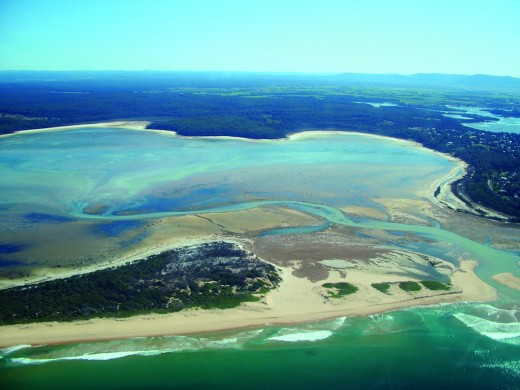 Lake Wollumboola – nominated RAMSAR wetland
(click photo to enlarge, then click to enlarge again!) Lake Wollumboola – nominated RAMSAR wetland
(click photo to enlarge, then click to enlarge again!)
.
.
History of Estuary and Catchment Use and Abuse
.
[Source: ‘Coastal Management in Australia – Key institutional and governance issues for coastal natural resource management and planning‘, (2006), published by the CRC for Coastal Zone, Estuary and Waterway Management, and supported by The Australian National University and the National Sea Change Taskforce, ^http://www.griffith.edu.au/__data/assets/pdf_file/0006/313359/Coastal_Management_in_Australia.pdf [Read More]
.
‘Critical to human health and the biological health of coastal waterways are factors influencing the discharge of waters, sediments, nutrients and pathogens into rivers and estuaries.
Throughout the 19th and 20th centuries, land clearance, soil erosion and urbanisation (including canal estates) have all contributed to the cumulative degradation of rivers, estuaries and coastal lakes.
Symptoms of the degradation are many including:
- Siltation of channels, which in some cases like on the Hunter has resulted in downstream displacement of shipping ports, and in the burial of estuarine sea grasses;
- Increased levels of nutrients, especially nitrogen and phosphorus, which are key elements for plankton and plant growth and trigger algal blooms when they reach excessive levels; and
- The presence of pathogens which may be digested by humans causing death and ill-health following consumption of seafood, or ingested while swimming.
.
Quite clearly urbanisation and deforestation has had some effect along the east coast.
The saga of Wallis Lake since the oyster contamination event of 1997 is there to remind us of the sensitivities of waters to pollutants. These sensitivities are not just biophysical and economic, but also lead to complex judicial proceedings on responsibilities under the common law concept of ‘duty of care’ as determined in the Wallis Lake case by the High Court.
We know that increasing nutrient loads or even the sediment loads from catchments into estuarine and lake systems may not trigger much change as these systems have considerable resilience to varying biophysical conditions. However, the fear is always that a lake/lagoon or estuary backwater will go beyond the ‘critical load point’. Turbidity and phytoplankton will then dominate.
It was such a concern that encouraged the then Planning Minister for NSW, Andrew Refshauge, in 2001, to stop a 2000-lot subdivision at Lake Wollumboola on the NSW south coast. This was at a location which years before had been zoned for such intensive urban use.’
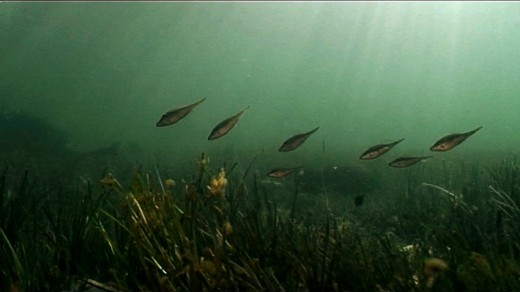
Seagrass Meadow
Source: ^http://www.hn.cma.nsw.gov.au/
..
‘Lake Wollumboola- Listing as a Ramsar site’
[Source: Amanda Findley, Shoalhaven Greens blogsite, 20110628, ^http://amandashoalhavengreens.blogspot.com/2011/06/lake-wollumboola-listing-as-ramsar-site.html]
 Black Swans and Teal (left) on Lake Wollumboola
© Photo by Frances Bray
(click photo to enlarge, then click to enlarge again! ~ you’re being looked at.) Black Swans and Teal (left) on Lake Wollumboola
© Photo by Frances Bray
(click photo to enlarge, then click to enlarge again! ~ you’re being looked at.)
.
.
‘Shoalhaven Council is it so narrow minded that it will not support taking a step forward in listing a lovely wetland in the RAMSAR register? seems so.
Department of Environment and Heritage have approached Council to advise that they wish to begin the process of talking to the community about listing this special little lake as a significant wetland- local campaigner Frances Bray sent the following letter to Council to try and influence tonights decision making.
Thanks Frances for allowing me to share this and your great photo of the swans and teals.’
~ Amanda Findley.
————————–
‘To General Manager and Shoalhaven City Councillors,
Please circulate this message to all Councillors,
I understand that at your meeting on Tuesday next, that you will consider a recommendation to oppose the listing of Lake Wollumboola as a Wetland of International importance under the Ramsar Convention.
Today I have been on a bird counting walk at Lake Wollumboola with ornithologist, Ms Joy Pegler. The Lake is an astonishing site, with Joy counting 1100 Black Swan, 957 Grey Teal and 536 Chestnut Teal, as well as 9 other species.
Here is a photo of some of the birds which are easily viewed from the north shore. Do come and enjoy this wonderful experience.
I urge you to think carefully about the benefits of Ramsar listing. Increased monitoring and research into this unique Lake would benefit its management, whilst maintaining current recreational activities. There would be significant benefits for the Aboriginal community from employment in management and Cultural tourism opportunities if community members choose to support Ramsar listing. The local and wider Shoalhaven community would benefit too from carefully promoted and managed national as well as international tourism.
The Lake Wollumboola Protection Association Inc as well as many Culburra Beach residents and ratepayers strongly support Ramsar listing, knowing the special qualities of the Lake especially for birds and understanding that Lake Wollumboola meets the relevant Ramsar criteria.
We understand that the NSW Office of Environment and Heritage is in the process of consulting the Aboriginal community regarding its views and we respect the need for that consultation to continue before the Office proceeds with consultation with the wider community.
Please do not jeopardise the planned consultations and the opportunities represented by Ramsar listing.’
Yours faithfully,
Frances Bray.
President Lake Wollumboola Protection Association Inc
.
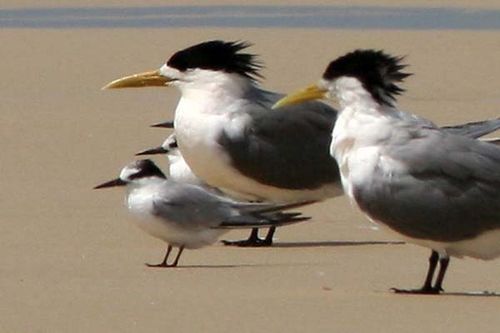 Little Terns Little Terns
.
.
Footnote
.
Ramsar Convention on Wetlands
.
The Convention on Wetlands of International Importance, called the Ramsar Convention, is an intergovernmental treaty that provides the framework for national action and international cooperation for the conservation and wise use of wetlands and their resources. The Ramsar Convention is the only global environmental treaty that deals with a particular ecosystem. The treaty was adopted in the Iranian city of Ramsar in 1971 and the Convention’s member countries cover all geographic regions of the planet.
The Convention on Wetlands is an intergovernmental treaty whose mission is “the conservation and wise use of all wetlands through local, regional and national actions and international cooperation, as a contribution towards achieving sustainable development throughout the world”. As of October 2010, 160 nations have joined the Convention as Contracting Parties, and more than 1900 wetlands around the world, covering over 186 million hectares, have been designated for inclusion in the Ramsar List of Wetlands of International Importance.’
The Ramsar Mission
‘The Convention’s mission is “the conservation and wise use of all wetlands through local and national actions and international cooperation, as a contribution towards achieving sustainable development throughout the world”.
The Convention uses a broad definition of the types of wetlands covered in its mission, including lakes and rivers, swamps and marshes, wet grasslands and peatlands, oases, estuaries, deltas and tidal flats, near-shore marine areas, mangroves and coral reefs, and human-made sites such as fish ponds, rice paddies, reservoirs, and salt pans.’
.
What are wetlands?
.
‘As defined by the Convention, wetlands include a wide variety of habitats such as marshes, peatlands, floodplains, rivers and lakes, and coastal areas such as saltmarshes, mangroves, and seagrass beds, but also coral reefs and other marine areas no deeper than six metres at low tide, as well as human-made wetlands such as waste-water treatment ponds and reservoirs.’
The Wise Use Concept
.
‘At the centre of the Ramsar philosophy is the “wise use” concept. The wise use of wetlands is defined as “the maintenance of their ecological character, achieved through the implementation of ecosystem approaches, within the context of sustainable development”. “Wise use” therefore has at its heart the conservation and sustainable use of wetlands and their resources, for the benefit of humankind*.’
.
[Source: ^http://www.ramsar.org]
.
*Editor: “for the benefit of humankind‘? Why so anthropocentric? It is not as if humankind has not benefited itself since it could at the expense of other species.
A more appropriate ending phrase would be:… “out of respect for the ecological rights of wetland-dependent species and ecological communities for survival, health and natural life processes, undisturbed”.
.
Further Reading:
.
[1] Lake Wollumboola Protection Association Inc. ^ http://www.wollumboola.org.au/
[2] ‘ Management of Amphibian Populations in Booderee National Park, South-Eastern Australia‘ (2010), by Trent D. Penman (University of Wollongong) and Traecey Brassil (NSW Department of Primary Industries) [ Read More]
[3] ‘Giving Little Terns Their Best Chance of Survival – Lake Wollumboola Little Tern Conservation Program’, (2008), by Frances Bray, ^ http://www.coastalconference.com/2008/papers2008/Bray,%20Frances%20Session%205A.pdf
[4] ‘ South Coast Shorebird Recovery Programme (2008/09 Breeding Season)’, ^ http://www.southcoastshorebirds.com.au/shorebird_downloads/annual_report/Shorebird%20Report%20200809final.pdf
[5] ‘Illawarra Bird Observers Club, Inc.’, ^ http://www.iboc.org.au/info/IBOCNewsMay2010.pdf
[6] R.J. Williams, G. West, D. Morrison and R.G. Creese, (2006), ‘ Estuarine Resources of New South Wales’, prepared for the Comprehensive Coastal Assessment (DoP) by the NSW Department of Primary Industries, Port Stephens.
[7] R.J. West, C.A. Thorogood, T.R. Walford and R.J. Williams. (1985), ‘ An Estuarine Inventory for New South Wales, Australia‘, Fisheries Bulletin 2. Department of Agriculture, New South Wales.
[8] ‘Wise Use of Wetlands‘ (Handbook 1), RAMSAR Convention on Wetlands,^ http://www.ramsar.org/pdf/lib/hbk4-01.pdf [ Read More]
.
– end of article –
Estuary and catchment use and abuse
Critical to human health and the biological health of coastal waterways are factors
influencing the discharge of waters, sediments, nutrients and pathogens into rivers and
estuaries. Throughout the 19th and 20th centuries, land clearance, soil erosion and
urbanisation (including canal estates) have all contributed to the cumulative
degradation of rivers, estuaries and coastal lakes. Symptoms of the degradation are
many including:
• siltation of channels, which in some cases like on the Hunter has resulted in
downstream displacement of shipping ports, and in the burial of estuarine sea
grasses;
• increased levels of nutrients, especially nitrogen and phosphorus, which are key
elements for plankton and plant growth and trigger algal blooms when they reach
excessive levels; and
• the presence of pathogens which may be digested by humans causing death and
ill-health following consumption of seafood, or ingested while swimming.
Quite clearly urbanisation and deforestation has had some effect along the east coast.
The saga of Wallis Lake since the oyster contamination event of 1997 is there to
remind us of the sensitivities of waters to pollutants. These sensitivities are not just
biophysical and economic, but also lead to complex judicial proceedings on
responsibilities under the common law concept of ‘duty of care’ as determined in the
Wallis Lake case by the High Court.
We know that increasing nutrient loads or even the sediment loads from catchments
into estuarine and lake systems may not trigger much change as these systems have
considerable resilience to varying biophysical conditions. However, the fear is always
that a lake/lagoon or estuary backwater will go beyond the ‘critical load point’. Turbidity
and phytoplankton will then dominate. It was such a concern that encouraged the then
Planning Minister for NSW, Andrew Refshauge, in 2001, to stop a 2000-lot subdivision
at Lake Wollumboola on the NSW south coast. This was at a location which years
before had been zoned for such intensive urban use.
Tags: Allen Price and Associates, Beecroft Peninsula, Birds (Migratory), Caspian Tern, Culburra Beach, golf course development, Jervis Bay National Park, keeping it real, Lake Wollumboola, Lake Wollumboola Protection Association, Little Tern, Ramsar Convention on Wetlands, Ramsar Wetlands, Shoalhaven, Shoalhaven Council, Southern Rivers Catchment Management Authority
Posted in 07 Habitat Conservation!, Birds (Migratory), Threats from Development | No Comments »
Add this post to Del.icio.us - Digg
Monday, August 29th, 2011
[The following article was initially published by Tigerquoll on CandoBetter.net on 20090730 under title ‘African Elephants – still slaughtered for tusk (‘ivory’) trinkets by backward Japanese and Chinese‘, with some modifications]
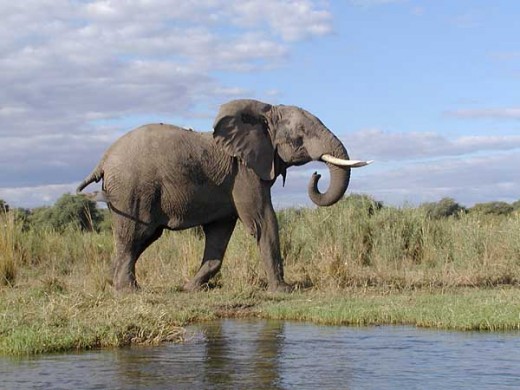 The magnificent African Bush Elephant bull (male) walking tall in its native savannah homeland
The magnificent African Bush Elephant bull (male) walking tall in its native savannah homeland
.
Out of Victorian colonial exploits of the 19th Century, elephant tusks could be found butchered and refined into expensive goods, notably billiard balls, piano keys, Scottish bagpipes, garment buttons, letter openers and for many ornamental items otherwise considered mere ‘trinkets’.
After the elephant tusk (‘ivory’) trade had decimated the African Elephant population from 1.3 million to 625,000, finally in 1989 the Environmental Investigation Agency (EIA) imposed a ban on this international elephant tusk (ivory) trade.
Ten years on, Zimbabwean dictator, Robert Mugabe, lifted the ban along with Botswana, Namibia, and South Africa and legalised the sale of elephant tusks from elephants they claimed (a) had died naturally or (b) been shot because they were violently aggressive or for ‘problem-animal’ control. In 1999, the Convention on International Trade in Endangered Species of Wild Fauna and Flora (CITES) authorized an auction of 50 tons of elephant tusks (ivory) from these four countries to the value of USD$5 million. Notably, the demand for elephant has been driven outside the African continent, in this episode mainly by Japan.
One could find a comparable solution for controlling Robert Mugabe…
 Tool of the Willing
(for just one day hire, …’our troubles there would be over very quickly’.)
~ borrowed from Colonel Walter E. Kurtz. Tool of the Willing
(for just one day hire, …’our troubles there would be over very quickly’.)
~ borrowed from Colonel Walter E. Kurtz.
.
In 2008, China was also given permission to become a licensed buyer of elephant tusks (ivory) and this followed 108 tons of elephant tusks (ivory) being auctioned from these same four African countries, representing the death of over 10,000 African elephants.
.
“The growing demand for elephant tusks (ivory) has increased black market prices from $200 per kilo to $850 per kilo in the past four years thus creating a big financial incentive for poachers. Michael Wamithi, program director for International Fund for Animal Welfare’s global elephants program, and former director of the Kenya Wildlife Service, declared: “An estimated 20,000 elephants are slaughtered annually for the trade in their tusks. Many African elephant range states clearly do not have the capacity or resources to combat these massive attacks on their countries’ wildlife heritage and the burgeoning markets in China are only fuelling these attacks.”
.
The Environmental Investigation Agency (EIA), which exposes environmental crimes, said CITES had ignored appeals from other African nations not to increase pressures on their elephant populations which were already struggling with wars, instability, droughts and poverty. EIA chairman Allan Thornton said:
“Responsibility for the poaching of 20,000 elephants in Africa each year will now lie with those who supported China obtaining legal ivory trade even though they continue to be the world’s biggest destination for poached ivory.”
 This elephant tusk (ivory) carving (photo) is a gift from China presented to the United Nations in 1974.
It depicts the Chengtu-Kunming railway, which was opened to traffic in 1970.
The sculpture was carved from eight elephant tusks. In elephant terms, four mature bull elephants were killed for this elaborate trinket. This elephant tusk (ivory) carving (photo) is a gift from China presented to the United Nations in 1974.
It depicts the Chengtu-Kunming railway, which was opened to traffic in 1970.
The sculpture was carved from eight elephant tusks. In elephant terms, four mature bull elephants were killed for this elaborate trinket.
One wonders whether the United Nations is still pleased with its eight bull elephant tusk trophy (shot and hacked off from a bull elephant like that above)?
.
.
Chinese, Japanese and Thais still Elephant Poaching in Africa
.
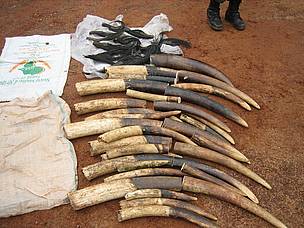
China and Japan bought 108 tonnes of ivory in another “one-off” sale in November 2008 from Botswana, South Africa, Namibia and Zimbabwe. At the time the idea was that these legal ivory sales may depress the price, thereby removing poaching pressure, an idea supported by both Traffic and WWF.
China’s increased involvement in infrastructure projects in Africa and the purchase of natural resources has alarmed many conservationists who fear the extraction of wildlife body parts is increasing. Since China was given “approved buyer” status by CITES, the smuggling of ivory seems to have increased alarmingly. Although, WWF and Traffic who supported the China sale, describe the increase in illegal ivory trade a possible “coincidence” others are less cautious. Chinese nationals working in Africa have been caught smuggling ivory in many African countries, with at least ten arrested at Kenyan airports in 2009. In many African countries domestic markets have grown, providing easy access to ivory, although the Asian ivory syndicates are most destructive buying and shipping tonnes at a time.
Contrary to the advice of CITES that prices may be depressed, and those that supported the sale of stockpiles in 2008, the price of ivory in China has greatly increased. Some believe this may be due to deliberate price fixing by those who bought the stockpile, echoing the warnings from the Japan Wildlife Conservation Society on price-fixing after sales to Japan in 1997, and monopoly given to traders who bought stockpiles from Burundi and Singapore in the 1980s. It may also be due to the exploding number of Chinese able to purchase luxury goods.
Despite arguments prevailing on the ivory trade for the last thirty years through CITES, there is one fact that virtually all informed parties now agree upon: poaching of African elephants is now seriously on the increase.’
.
.
‘Shopping habits of China’s ‘suddenly wealthy’
[Source: by Rose Gamble, freelance journalist, FT.com, 20090821, ^http://www.ft.com/cms/s/2/9271a266-8d21-11de-a540-00144feabdc0.html#ixzz1WPkaKde6, accessed 20110829]
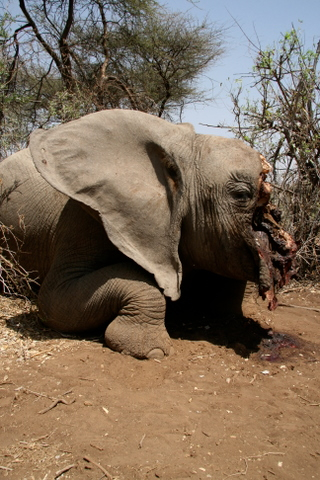
.
Ivory:
‘For more than 7,000 years, Chinese artisans have been crafting elephant ivory. Favoured by the Imperial household as far back as the Qing dynasty (1680), ivory has an illustrious reputation and an association with the wealthy and elite. But in 1989, the trading of ivory was banned worldwide through the Convention on International Trade in Endangered Species (Cites), after more than half of Africa’s 1.3 million elephants were poached in a single decade. And yet, with a carving trade established in antiquity and a burgeoning middle class who, for the first time, can afford to buy ivory, China remains its biggest importer.
As Asian elephant herds dwindle, African elephants have become the only source of ivory.
In late 2008, Cites authorities allowed China to bid with Japan for tusks from official stockpiles – consisting of ivory collected from elephants that had died a natural death – in four southern African countries. In an open declaration of a continuing demand, 12 Chinese traders bought 62 tonnes at an average price of $144 per kilo. Since this legal purchase, more than 11 tonnes of illegal African ivory have been impounded en route to China.
Elephant poaching largely takes place in central Africa, where poverty and political instability are rife. Chronic unemployment, the availability of firearms and corruption all facilitate the illegal ivory trade. These regions are also home to unregulated domestic ivory markets, where carved items are bought and sold. According to ivory expert Esmond Martin, the majority of buyers are Chinese. In a scramble for Africa’s minerals and resources, the continent has seen a recent influx of Chinese workers – a presence that is visibly reflected in the illegal retailing of ivory. On a recent trip to Addis Ababa, Ethiopia, Martin recorded 1,433 items of ivory openly displayed in the city’s main streets and central market. Among these were 149 pairs of freshly carved ivory chopsticks, selling for $16 each – in sharp contrast to a Chinese retail price of $139 – and signature stamps and jewellery. All of these items were small enough to potentially smuggle through customs.
Martin had previously estimated that 4,900 to 12,000 elephants from central Africa were killed each year to supply tusks to the craftsmen of Africa, China and Thailand.
Conservationists are deeply concerned. According to Barbara Maas, CEO of Care for the Wild International: “With the number of Chinese nationals resident in Africa rising, and poaching on the increase, the frontline between supply and demand for ivory is now perilously close, with a disastrous outcome for elephants.”
.
..
‘Campaigners’ fear for elephants, and their own credibility’
[Source: The Economist, 20080717, ^http://www.economist.com/node/11751304 ]
.
‘Nobody can deny that China’s black market was rampant until recently. In a report to the UN leaked by the Environmental Investigation Agency (EIA), a campaigning group, this month, Chinese officials admitted that between 1991 and 2002 they had lost sight of 121 tonnes of ivory, the equivalent of the tusks from 11,000 elephants.
Is China observing the CITES rules now? A brief visit to China in 2007 by inspectors from the CITES secretariat suggested that things had improved: they said that ivory was becoming harder to find, though they came across a shop in the city of Xi’an with ivory carvings of dubious provenance. A bigger investigation was carried out by TRAFFIC, an independent British-based group that monitors wildlife trade. After studying 10,000 shops between 2006 and 2008, it reported a progressive decline in the availability of illegal ivory. This had coincided with greater police vigilance.
The idea that China is cleaning up its act got another boost in March, when over 750kg (1,650lb) of raw ivory was seized in Guangxi Province. As CITES notes, the penalties for illegal trading include life imprisonment and death. But the EIA, which uses undercover methods to probe the trade, says things are not as good as they seem; in 2007 its researchers found a roomful of illegal ivory, including an uncut tusk, for sale in the city of Dalian. Last month they made a small find in Gansu province.
A more interesting question is how the legal sales now in prospect will affect the black market. A fresh supply of legal ivory may depress the price, and reduce the incentive to poach. TRAFFIC notes that after a legal auction in 1999, the price fell; this led to a decline in poaching over five years. For doctrinaire types, who oppose all trade in ivory, the forthcoming sale is not just a challenge to endangered animals; it could be a threat to the credibility of their best-loved arguments.’
.
.
‘Data shows illegal ivory trade on rise’
[Source: World Wildlife Fund (WWF), Cambridge, UK, 20091116, ^http://wwf.panda.org/wwf_news/?uNewsID=180702, accessed 20110829]

.
‘The illicit trade in ivory, which has been increasing in volume since 2004, moved sharply upward in 2009, according to the latest analysis of seizure data in the Elephant Trade Information System (ETIS).
ETIS, one of the two monitoring systems for elephants under CITES (the Convention on International Trade in Endangered Species of Wild Fauna and Flora) but managed by TRAFFIC, holds the world’s largest collection of elephant product seizure records.
The analysis, undertaken in advance of the 15th meeting of the Conference of the Parties (CoP15) to CITES, was based upon 14,364 elephant product seizure records from 85 countries or territories since 1989, nearly 2,000 more records than the previous analysis, in 2007.
The remarkable surge in 2009 reflects a series of large-scale ivory seizure events that suggest increased involvement of organized crime syndicates in the trade, connecting African source countries with Asian end-use markets. The ETIS data indicate that such syndicates have become stronger and more active over the last decade.
There continues to be a highly significant correlation between large-scale domestic ivory markets in Asia and Africa and poor law enforcement, suggesting that illicit ivory trade flows typically follow a path to destinations where law enforcement is weak and markets function with little regulatory impediment.
Indeed, the rise in illicit trade in ivory indicates that implementation of a CITES “action plan for the control of trade in African elephant ivory,” the Convention’s principal vehicle for closing such unregulated and illicit domestic markets in Africa and Asia, has failed to drive any significant change over the last five years.
The ETIS analysis identifies Nigeria, the Democratic Republic of the Congo and Thailand as the three countries most heavily implicated in the global illicit ivory trade. Illegal trade involving each of these nations has been repeatedly singled out for priority attention since the first assessment in 2002, but they continue to feature as critical hotspots in the trade as sources, entrêpots and consumers of ivory.
Another nine countries and territories—Cameroon, Gabon and Mozambique in Africa and Hong Kong SAR, Malaysia, the Philippines, Singapore, Taiwan and Vietnam in Asia—were also identified as important nodes in the illicit ivory trade.
China, which along with Japan was an approved destination of the legal, CITES-sanctioned one-off ivory sale in 2008, faces a persistent illegal trade challenge from Chinese nationals now based in Africa. Ongoing evidence highlights widespread involvement of overseas Chinese in the illicit procurement of ivory, a problem that needs to be addressed through an aggressive outreach and awareness initiative directed at Chinese communities living abroad.
The results are less clear-cut concerning the impacts of the CITES approved one-off ivory sales in 1999 and 2008.
Following the first such sale, in June 1999, there was a progressive decline in the illicit trade in ivory for five years, with no evidence to suggest that the sale had resulted in an increase in the illicit ivory trade globally.
After the second CITES-approved ivory sale, in late 2008, the results are unclear as to whether it has stimulated increase demand or whether it has simply coincided with an increase in supply that was already underway over the last four years. The collection of more data over an extended time period will throw further light on this vital issue.’
.
The full ETIS report can be downloaded from the CITES website as document at ^http://www.cites.org/common/cop/15/doc/E15-44-01A.pdf
[Read More]
.
.
‘China Fuels East African Elephant Poaching’
[Source: Damian Robin, Epoch Times, 20100330, ^http://www.theepochtimes.com/n2/content/view/32389/, accessed 20110829]
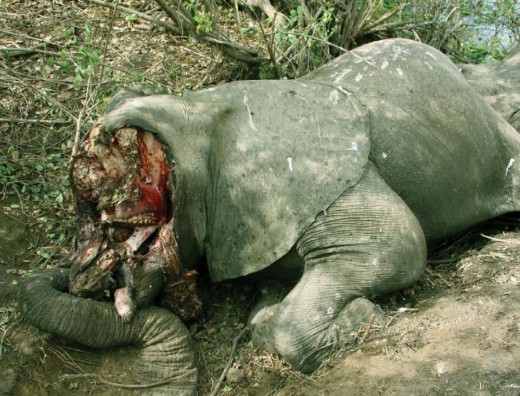
.
China’s influence in East Africa is fueling an upsurge in elephant poaching, gunrunning, and corruption according to a report on U.K. television Friday. A Channel 4 reporter spoke to people in villages and cities, wildlife managers, rangers, government officials, and illegal ivory sellers in Kenya and Tanzania—all of whom said China is the main buyer of banned ivory.
Filmed secretly, sellers told the journalist from Unreported World that during a presidential visit from Chinese Communist Party leader Hu Jintao in 2009, two hundred kilos of ivory was bought by Chinese diplomats and taken out of Tanzania.
The sellers did not say if Hu knew of the trade, but did say that a prominent diplomat from the Chinese Embassy frequently bought large amounts of ivory from them.
Kooky Gorman owns a wildlife park in Kenya. Accompanied by armed rangers, she took the reporter to many spots in her park, where elephant carcasses rotted, their heads split open to make it easy to saw the tusks off.
Many hides showed multiple bullet holes. The lead ranger said the killers had used AK47 automatic weapons to spray herds. The shootings were indiscriminate, killing young and old.
Gorman said the weapons were bought from neighboring Somalia where the civil war has continued since 1991.
The intensity of the poaching has been increasing for the past two years. In 2007 six elephants were poached from her park. In 2008, twenty-eight were poached. Fifty-seven were poached in 2009.
She says there is a threat of elephant extinction.
The Kenya Wildlife Service has strong rooms full of tusks and carved ivory taken during raids and confiscated at Nairobi airport. It has about 65 tons to 70 tons estimated at $10 million.
The U.N. recently rejected Zambia and Tanzania’s request to hold a one-off sale for their ivory stockpile, valued of approximately $15 million.
Since trade in ivory was stopped in 1989, some countries have been allowed to do a small amount of business in ivory if they have good conservation measures. Zambia and Tanzania are currently prohibited from any trade in ivory. The International Trade of Endangered Species of Fauna and Flora (CITES) annual meeting in Doha disregarded arguments that the sale could help police wildlife parks and stop the burden of protecting the horde of ivory.
Selous Game Reserve in Tanzania has 40,000 elephants.
On the TV program, a police informant who lived nearby in a village known for its illegal ivory deals said armed groups of 30 often came from Dara Salam in Senegal to take back ivory in 440-to-660-pound batches. (An average tusk weighs about 4.4 pounds.)
The informant, whose face was not shown for fear of reprisals, had had his house burned down recently.
Another man, who did not want to be identified as he had received death threats, was a safari operator who brings tourists to the Selous Reserve. “I think the wildlife department knows exactly what’s going on here,” he said. “There are some members of the games department who are poaching to supplement their pay and feed their families.”
He said he thinks movers are coming from China and the Far East to take bones and that they are in collusion with local authorities.
He said they could not get through the 15 to 20 policed roadblocks without help from “some very well-placed people.”
One illegal dealer said he had friends in airport security. “It’s no problem with money,” he told the reporter. “If you have money, it’s easy.”
There is a small industry carving the poached ivory for the East Asian trade. “Many people from China come and buy,” he said. There is a market for trinkets, seals, and chopsticks.
Chinese regime officials told Unreported World that they are against the illegal ivory trade and that Chinese diplomats did not illegally purchase or export ivory by misusing diplomatic immunity in 2009.
Most villagers have stood by while violence around the poaching continues. They felt threatened and were unable to prevent the elephant deaths. Now, many see tourism as the main way they can earn a living, so they are protecting the animals and habitat as much as they can.’

.
.
‘Ivory Stockpile Sale Rejected by U.N.’
[Source: Peter Valk, The Epoch Times, 20100324, ^http://www.theepochtimes.com/n2/content/view/31944/, accessed 20110829]
.
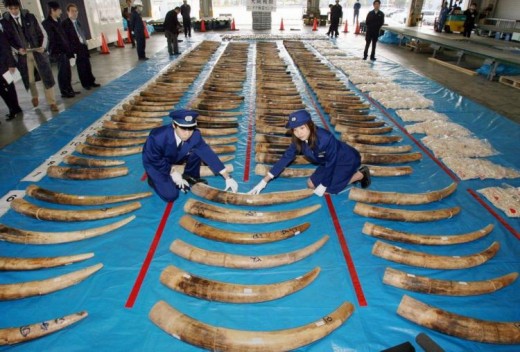 Custom officers display a total of 2.8 tons of ivory on March 1, 2007, a record amount seized in Japan, a top black market destination for elephant tusks.
The U.N.’s Convention on the International Trade of Endangered Species of Fauna and Flora rejected Zambia and Tanzania’s request to sell it’s stockpile of ivory.
(AFP/Getty Images)
. Custom officers display a total of 2.8 tons of ivory on March 1, 2007, a record amount seized in Japan, a top black market destination for elephant tusks.
The U.N.’s Convention on the International Trade of Endangered Species of Fauna and Flora rejected Zambia and Tanzania’s request to sell it’s stockpile of ivory.
(AFP/Getty Images)
.
‘Zambia and Tanzania’s request to hold a one-off sale for their ivory stockpile, valued of approximately $15 million, were rejected during the U.N.’s Convention on the International Trade of Endangered Species of Fauna and Flora (CITES) annual meeting in Doha. The increase of poaching and illegal ivory sales in both countries in 2009 were the main reasons for the rejection.
Since the ivory trade was banned in 1989, there has been an exemption that allows countries that have proven effective in conservation measures to have a small amount of regulated trade in ivory. Currently, Zambia and Tanzania are forbidden to sell ivory.
“It’s crucial that central and western African nations suppress the brazen poaching, mainly fueled by organized crime and illegal ivory markets openly operating within their borders before any further ivory sales take place,” said Sybille Klenzendorf, managing director of Species Conservation at WWF-U.S. in a press release.
According to a report from the Elephant Trade Information System (ETIS), which keeps track of ivory seizures, there exists a direct relationship between an increase in poaching and poor law enforcement. In the past two years, the number of elephants that were killed as a result of poaching has quadrupled.
Opponents of the ban say that Tanzania ought be allowed to dispose of their ivory stockpile as to avoid spending large sums of money on security and storage.
During the meeting, in which 175 countries participated, some animals were added to the list of protected species. The rise of e-commerce is now believed to be one of the latest and biggest threats to wildlife, as global Internet access has made it increasingly easy to buy and sell illegal wildlife products with little control.
“The transactions kind of come and go and take place before anybody really even knows it, leaving it to the post office to be enforcing this global regime of trade regulation,” Paul Todd, a campaign manager for the International Fund for Animal Welfare (FAW) was reported as saying by ABC news in Australia.
Back in 2005, a FAW investigation reported that in one week alone, over 9,000 live animals or products in five categories of animals were for sale on English-language Web sites, chat rooms and the popular auction site eBay. Some of the live animals found included a gorilla in London, and a Siberian tiger in the U.S. Body parts and products were also commonly found with ivory being common.’
.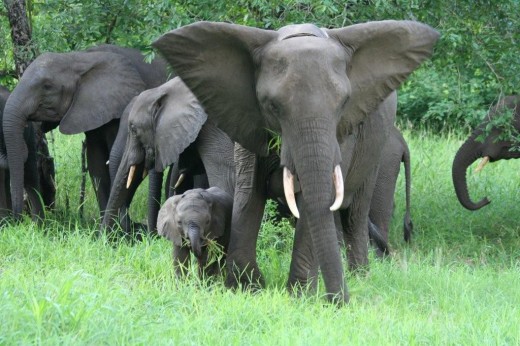
An African Elephant herd
(click photo to enlarge)
Elephants are very intelligent, lifelong loyal and have immense family bonds.
A female elephant listens and watches the photographer intently, with her young close to her side.
An elephant mother will protect her calf to her death.
.
.
 Australia’s big ‘game hunter’, Robert Borsak in Zimbabwe (2008)
Australia’s big ‘game hunter’, Robert Borsak in Zimbabwe (2008)
.

‘Macdonald’s game council thrill killer‘
by Andrew Clennell, State Political Editor, Sydney Morning Herald, 20090721, ^http://www.smh.com.au/environment/conservation/macdonalds-game-council-thrill-killer-20090720-dqui.html]
.
Robert Borsak (on the NSW Government’s Game Council) went to northern Zimbabwe to hunt elephants. On a two-week trip he killed several, including a bull elephant he shot in the head from a distance of six paces.”My reflexes took over as the rifle fired … he went down, as if in slow motion,” writes Mr Borsak in an article entitled Bulls in the Rain posted on the internet. “It was awesome. He did not know what had hit him.”Back in Australia, Mr Borsak has bagged another prize. The big game hunter and former vice-chairman of the Shooters Party is being paid $342 for each sitting day as chairman of the Game Council of NSW, one of 58 quangos which operate under the Primary Industries Minister, Ian Macdonald.
Mr Borsak hopes to run for the Shooters Party at the next election. If successful, he would join a party that now holds the balance of power in the upper house and is holding the Government to ransom after Mr Macdonald failed to negotiate through cabinet the right to shoot in National Parks.It is an example of the kind of interests the embattled Mr Macdonald is accused of helping to protect in some of the committees and statutory bodies he oversees.Mr Borsak is being paid $342 a sitting day for his part in regulating hunting in this state. Conservationists say the Game Council’s only purpose is to win the Shooters Party votes.Last week there were revelations the minister spent close to $150,000 on a wine industry council he set up, chaired by his friend Greg Jones; and that the minister had put other Labor identities – such as union boss Russ Collison and former Labor MPs – on quangos.The Herald learned yesterday Mr Macdonald appointed a friend of 25 years, John Gerathy, the law partner of former Labor deputy prime minister Lionel Bowen, to the wine council and the Homebush motor racing board.
Mr Macdonald is under siege. Yesterday the acting Opposition Leader, Andrew Stoner, referred him to the Independent Commission Against Corruption over claims he gave special treatment to another Labor mate, the former construction union president John Maitland, over granting an exploratory licence for a Hunter Valley mine.
The Premier, Nathan Rees, refused to comment yesterday when asked if the Left assistant secretary Luke Foley, who wants Mr Macdonald’s upper house seat, would be a better cabinet minister than Mr Macdonald.
As for Mr Borsak, he was resentful yesterday that he might be included in a story to do with Mr Macdonald.
The Game Council has received more than $11 million in government funding since 2002 and $3.5 million last year, despite promises from Mr Macdonald it would end up being self-funded.
Mr Borsak said the Game Council was set up in 2002, before Mr Macdonald was minister, and should not be lumped in with other committees as it was a statutory body. He said he was a businessman who received “a grand total of $1368 for last financial year for about 60 days’ work for the council”.
“Why would there be a conflict of interest,” Mr Borsak said, when asked whether his involvement in the Shooters Party might mean he should not be involved in the Game Council. He said of the Zimbabwe hunt: “The fact is I do it [the hunt] and I do it legally and I did it as part of licensed conservation programs. The … tusks belong to the Zimbabwean Government.”
The executive director of the Nature Conservation Council, Cate Faehrmann, said it was time the Game Council’s “activities were thoroughly scrutinised”.
Mr Maddonald’s “aggressive support of the establishment of game reserves and hunting in National Parks is all the more insidious when you realise at least one of the people behind this push likes to kill elephants in his spare time,” she said.
“By pumping millions of dollars into the Game Council, Minister Macdonald is sanctioning bloodsports.”
Mr Stoner called for Mr Macdonald to be sacked. “It seems every day there are more doubts raised about Ian Macdonald … There will be more, so Nathan Rees should do the right thing and sack this minister.”
.
.
‘The cruelty and corruption of the elephant hunt’
[Source: Sydney Morning Herald, following letters to the editor, 20090722, ^http://www.smh.com.au/environment/conservation/the-cruelty-and-corruption-of-the-elephant-hunt-20090722-dtb3.html]
.
Letters to the Editor
‘I began hunting as soon as I was old enough to use a rifle. But the photo of Robert Borsak gloating over the body of an elephant he shot in Zimbabwe fills me with disgust (“Macdonald’s game council thrill killer”, July 21).Zimbabwe is one of few African countries to allow this practice. People typically pay about $US20,000-$26,000 ($25,000-$32,000) for this privilege. Bulls are more expensive, presumably because of their tusks. Where does this money go? Here is a hint.
Advertisement: Story continues belowThe BBC reported a decade ago that the government of Robert Mugabe earned US$2.5 million by selling 20 tonnes of elephant tusks, although the ivory trade had been banned. Zimbabwe lies about its elephant population to get around the ban. This practice is probably greater today.As the economy collapsed, the Zimbabwean Army, the key to Mugabe’s survival, cancelled all contracts to supply beef. The Zimbabwean Conservation Task Force reports soldiers have complained the only meat they are given is from elephants. So in addition to the immense pleasure Borsak apparently feels in the senseless destruction of a great creature, he can also take pride in doing his bit to keep Africa’s worst despot in power.’~ Don Moore, Lilyfield
.
.
‘I loved the juxtaposition of the stories about Robert Borsak, and Sining Wang and Edward Liew (“Don’t have a cow man – it’s got rights”, July 21). Thank heavens for the next generation of intelligent and compassionate thinkers. I hope it is only a matter of time before Wang and Liew can flex their legal muscles against thug shooters such as Borsak. The sooner they are banned from indulging in their cruel and destructive hobbies, the better.’~ Belinda Connolly, Caringbah
.
.
‘It has been said that people get the politicians they deserve.What does it say about the people of NSW when there is a danger of Robert Borsak standing for a seat in Parliament – a man who admits to the thrill of downing a bull elephant “from a distance of six paces”?’Jill Klopfer, Wahroonga
.
.
‘So Robert Borsak killed elephants in Zimbabwe “as part of licensed conservation programs”.The corrupt Zimbabwean Government and conservation are complete strangers, as anyone who has anything to do with trying to save what is left of Zimbabwe’s wildlife can tell you.’Colleen Riga, Potts Point
.
.
‘Robert Borsak says “the tusks belong to the Zimbabwean Government”. No – the tusks belong to the elephant.’Jean-Marc Russ, Darlinghurst
.
.
‘It comes as no surprise to learn of Ian Macdonald’s patronage of hunters. The minister has shown scant regard for the welfare of animals, as those of us working in animal charities can attest. His $3.5 million for the Game Council compares with the $533,000 in funding he announced in April to be split between the RSPCA, Animal Welfare League, WIRES, Cat Protection Society and the Domestic Animal Birth Control Co-operative Society.The Government opposes Clover Moore’s bill to reduce the suffering of cats and dogs by regulating their sale, and even pleas for an inquiry into the welfare of companion animals have been rejected. A minister who gives priority to working with a hunter who describes shooting an elephant as awesome is hardly likely to care that tens of thousands of cats and dogs are killed annually on his watch.’
Kristina Vesk chief executive, Cat Protection Society of NSW, Newtown
.
– end of article –
Tags: African Elephant, Chinese illicit ivory trade, cites, Convention on International Trade in Endangered Species of Wild Fauna and Flora, Environmental Investigation Agency, illegal ivory trade, Ivory trafficking, ivory trinkets, Japanese illicit ivory trade, Robert Mugabe, Selous Game Reserve, Thai illicit ivory trade, TRAFFIC
Posted in Africa, Elephants, Threats from Poaching and Poisoning | 1 Comment »
Add this post to Del.icio.us - Digg
Monday, August 29th, 2011
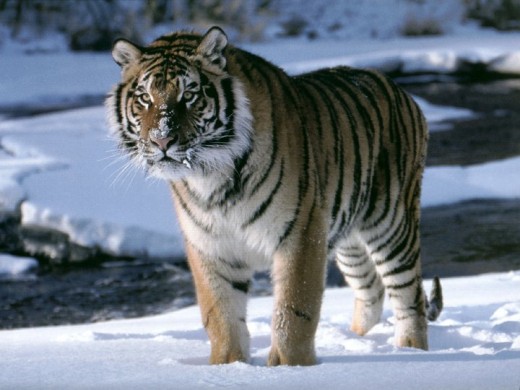 The magnificent tiger in the wild, where it belongs,
free, protected from humanity, protected from human persecution, protected from backward superstition.
A big ask of a pathogenic backward species ~ homo ‘sapiens’? The magnificent tiger in the wild, where it belongs,
free, protected from humanity, protected from human persecution, protected from backward superstition.
A big ask of a pathogenic backward species ~ homo ‘sapiens’?
.
“I hold that the more helpless a creature, the more entitled it is to protection by man from the cruelty of man”
.
“The greatness of a nation and its moral progress can be judged by the way it treats its animals.”
~Mohandas Gandhi (1869-1948)
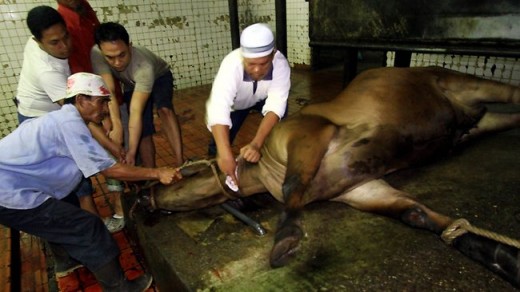 By this measure, Indonesian society’s prescription and tolerance of Dhabiha throat slitting slaughter in its abattoirs reflects a society that is barbaric, immoral, uncivilized and backward. By this measure, Indonesian society’s prescription and tolerance of Dhabiha throat slitting slaughter in its abattoirs reflects a society that is barbaric, immoral, uncivilized and backward.
.
.
Then we have the backward cultural practice of Traditional Chinese Medicine (TCM):
.
‘Diplomat exposed Chinese tiger farm horrors’
[by Jonathan Watts, 20110827, The Age newspaper, borrowed in turn from The (UK) Guardian News & Media, ^http://www.theage.com.au/environment/animals/diplomat-exposed-chinese-tiger-farm-horrors-20110826-1jefp.html, accessed 20110829]
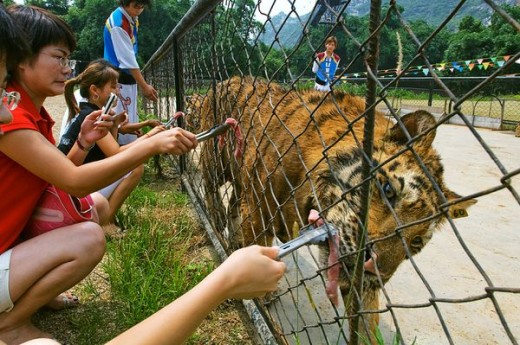 Chinese tormenting a Xiongsen Tiger Chinese tormenting a Xiongsen Tiger
.
‘An American diplomat posed as a Korean tourist to investigate a notorious tiger breeding centre in southern China, where he saw animals whipped, made to perform ”marriage processions” and reportedly sold to be used in traditional medicines.As a result of the undercover visit to Xiongsen Tiger and Bear farm, the US government was notified of doubts about China’s conservation efforts, according to a diplomatic cable recently released by WikiLeaks.
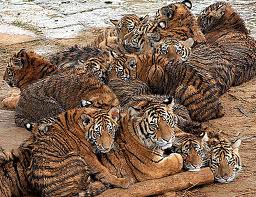 Xiongsen Tiger – a pitiful end Xiongsen Tiger – a pitiful end
The investigation was inspired by a flurry of foreign media reports in 2007 alleging the farm offered tiger meat in its restaurant and tiger bone wine in a shop.
In a cable sent from the Guangzhou US consulate headed ”Devouring Dragon, Disappearing Tigers”, an un-named economics officer said he was initially treated with suspicion by the sales personnel in the facility. But once he convinced them he was Korean, they became eager to do business.
”The staff stated that up to three tour groups of Koreans came a day, numbering more than 30 in each group.The Koreans were among the most enthusiastic purchasers of both the black bear bile and the tiger wine.” The price of the bottles ranged from 80-896 yuan ($12-$134).
 Tiger Parts used by in barbaric chinese superstition (TCM) Tiger Parts used by in barbaric chinese superstition (TCM)
.
China says it has nearly 6000 tigers in captivity, but only 50 to 60 are left in the wild. In the 1980s, China set up tiger farms to try to preserve the big cats. But conservationists have criticised the farms, accusing them of seeking primarily to produce tiger parts, which some Asians regard as aphrodisiacs.
 Packaged Traditional Chinese ‘Medicine’ Packaged Traditional Chinese ‘Medicine’
[About as effective as eating garden snails]
.
The visitor to the farm – which has more than 1000 tigers in its cages – described the spectacle of a tiger killing an ox in a ”training cage” purportedly set aside as a training area for animals that are to be introduced to the wild. But most of the animals appeared tame and some were used in circus-like entertainment shows, where they were beaten. Black bears – kept for their bile – were also made to join a mock Chinese marriage procession where they acted as bride and groom, he wrote.
 Xiongsen Bear and Tiger Mountain Village
(a backward cruel colosseum for human hedonistic animal sadism) Xiongsen Bear and Tiger Mountain Village
(a backward cruel colosseum for human hedonistic animal sadism)
.
Locals told him that the farm served tiger meat and sold tiger skin, but this was denied by staff.
Nonetheless, he concludes in the cable dated July 12, 2007, that:
”The commercial nature of the farm was troubling. The large number of endangered tigers and bears present with no current plans to reintroduce them into the wild raises concern regarding the motivation of such a farm.”
.
Four years later, these concerns remain valid. Reports earlier this year suggest the tiger population of the farm has grown.’
.
 A threatened and persecuted species by backward human cultures,
reduced to the mercy of civilized humanity’s compassion and whim. A threatened and persecuted species by backward human cultures,
reduced to the mercy of civilized humanity’s compassion and whim.
.
 Gong Xi Fa Cai
[Chinese Year of the Tiger ~ a harbinger of mass slaughter] Gong Xi Fa Cai
[Chinese Year of the Tiger ~ a harbinger of mass slaughter]
.
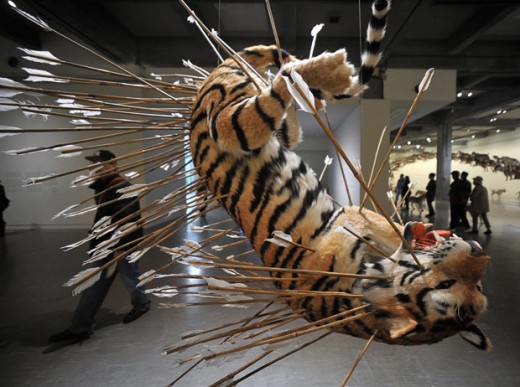 2010 was the Chinese Zodiac Year of the Tiger 2010 was the Chinese Zodiac Year of the Tiger
.
.
Footnote
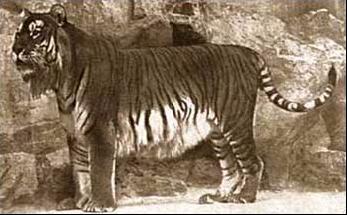 Rare photo of a Caspian Tiger Rare photo of a Caspian Tiger
.
Until the 19th century, Caspian tigers still inhabited wide spaces of Western and Central Asia. In the mid-19th century, Caspian tigers were killed 180 km northeast of Atbasar, Kazakhstan and as far North as near Barnaul, Russia.
The only reported Caspian tiger from Iraq was killed near Mosul in 1887. In 1899, the last Caspian tiger near the Lop Nur basin in Xinjiang, China, was killed. Caspian tigers disappeared from the Tarim River basin in Xinjiang, China, by the 1920s.
The last record of the Caspian tiger on the Ili River, their last stronghold in the region of Lake Balkhash, Kazakhstan, dates to 1948.
 Caspian Tigers now are extinct. They only exist in illustration. Caspian Tigers now are extinct. They only exist in illustration.
.
.
– end of article –
Tags: backward cultures, Chinese Tiger Farm, Dhabiha, Indonesian abattoirs, TCM, tiger bone, tiger parts, Traditional Chinese Medicine, WikiLeaks, Xiongsen Bear and Tiger Mountain Village, Xiongsen Tiger, Xiongsen Tiger and Bear farm, Xiongsen Tiger Mountain Village
Posted in Threats from Poaching and Poisoning, Tigers | 1 Comment »
Add this post to Del.icio.us - Digg
Sunday, August 28th, 2011
The following article was initially published by Tigerquoll on CanDoBetter.net 20090416 under the title: ‘ACT Environment Commissioner unqualified to condemn kangaroos’:
.
One day kangaroos grazing on Australian grasslands (long deforested by colonists)…
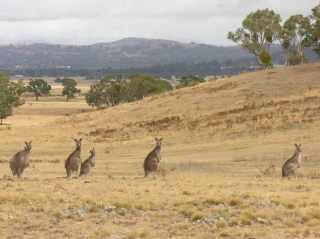
Next day, thanks to the ACT Commissioner for Sustainability and the Environment….
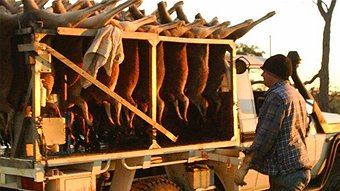
ACT Commissioner for Sustainability and the Environment, Dr Maxine Cooper, is the Australia Capital Territory’s inaugural full-time Commissioner in the role, yet what relevant environmental qualifications and experience does the incumbent have, or indeed lack, to be officially condemning another local indigenous population of Australia’s iconic marsupials, our kangaroos, to slaughter for pet food?

The Environment Commissioner’s own website lists her formal qualifications in the areas of:
- Environmental Planning
- Environmental Design
- Environmental Science
.
All these ‘environmentally’ friendly prefixes sound impressive, until one realises that each of these areas of academic study are not fauna focused, but indeed are all about human-centric utilisation of the natural environment for the benefit of humans. That is, these qualifications are all about maximising the convenience of the environment for humans. A wolf in charge of the kangaroos? It’s just like forestry pretending to care about forests.
Such qualifications offer no insight into the survival and habitat needs of Australian wildlife. “According to ACT’s inaugural Environment Commissioner, kangaroos at Belconnen were a threat to certain vulnerable and endangered species of fauna and flora on the site. Where’s the bloody independent zoological evidence, who would attest to this view under the test of peer scrutiny?
Now if our roo-shooting redneck commissioner had a more relevant Bachelor of Science in Zoology from say the University of Melbourne, she may be of a contrary mindset and less aligned to human planning needs and monetary gains; instead more empathetic to ecological needs of native fauna. The introductory paragraph for the University of Melbourne’s Honours degree in Zoology instills the following focus:
.
“How animals live and why they live that way are questions addressed by zoologists. Most of the Australian fauna are poorly understood or not even formally named, yet informed management and resource use of Australia’s flora, fauna and habitats depend upon zoological knowledge. We need to catalogue what species exist and how they survive in their natural environments. This requires knowledge of their physiology, breeding and reproductive systems, ecology, evolution and behaviour.”
[SOURCE: http://www.unimelb.edu.au/HB/areas/SZOOL.html]
Maxine Cooper, where are your qualifications in Zoology, in Conservation and in Australian wildlife to entitle you to officially condemn thousands of Australia’s iconic kangaroos to slaughter for cat and dog food?
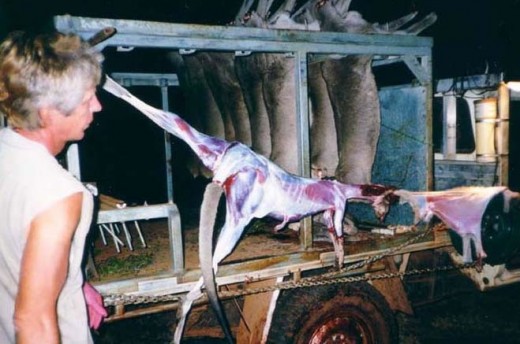
Can you guarantee the Australian public that none of these kangaroos is to be minced for cat and dog food?
The standard setting for the job prerequisites for the ACT’s Environment Commissioner are woeful and clearly not in the best interests of the target subject – our natural wildlife. What were they thinking by employing a planner in environmental management?
.
.
.
Editor’s comment:
.
The stated role of the OCSE is to:
.
- ‘Investigate complaints about the management of the environment by the Territory or a Territory authority’
- ‘Conducts investigations as directed by the Minister’
- ‘Initiates investigations into actions of an agency where those actions would have a substantial impact on the environment of the ACT’
- ‘Produces state of the environment reports for the ACT and the 17 councils in the Australian Capital Region’
- ‘Makes recommendations for consideration by government and includes in our annual report the outcomes of those recommendations’
- ‘Resolves issues through mediation and conflict resolution’
- ‘Undertakes an advocacy and awareness role on sustainability and environmental issues.’
.
[Source: OCSE website, ^http://www.envcomm.act.gov.au/our_office]
.
So it basically seems to be an ACT Government environmental watchdog agency. Why?
The ACT covers only 2400 square kilometres and has under 400,000 people. It already has an Environment and Sustainable Development Directorate [Read More], which lumps disparate functions under one watered down super-ministry including environment, water, climate change, planning (including development assessment, leasing, construction, land use and utilities regulation, surveying and land information), the Government architect, heritage, transport planning and nature conservation.
So is OCSE the watchdog for one overburdened super-ministry? It is bureacracy gone mad. Since Canberra is the seat of the federal government and ACT is so small, why not just have the Federal Government look after ACT conservation matters and be cost effective with taxpapers’ money?
.
It is gross deceptive greenwash when the Australian Capital Territory government merges all its conservation responsibility into one super agency, The Office of the Commissioner for Sustainability and the Environment, (OCSE), then heads it up with a town planner [Read More], then tries to claims that it has custodial responsibility for environment and conservation on behalf of the people of the ACT. It is wholly consistent with government’s misuse and abuse of the word ‘sustainability‘ ~ to mean any action that sustains the government’s conveniences and political ends, such as land use development of grasslands for industry. The Office is simply a development planning arm of the ACT Government and many Canberra-based property developers are very happy with the arrangement thank you very much.
But it is the biased leading the inept when one reads a report, ‘Report of the Grassland Forum‘ dated 20 May 2010 on the website of this Office of the Commissioner for Sustainability and the Environment.
The report considers the future potential of the 10,000 hectares of native grassland just outside Canberra.
This report was not compiled not internally (probably because the OCSE employs not competent environmental scientists to do so), but believe it or not by a property development consulting firm ‘Beaconhill Consulting‘. ‘Beaconhill Consulting’s recent work is listed on its website as:
- Strategic performance review of a major multi-program investment portfolio valued at several hundred million dollars
- Due diligence examination of a multi-million dollar import business investment – supply chain and market analyses, review of product efficacy and policy framework
- Strategic Business Development for an emerging export business – Board level reforms and strategies, business plan development, commercialisation strategy, marketing plans, industry development application, governance arrangements and commercial partner negotiations
- Business Development, government submissions, marketing plans, and client tenders.
.
The ‘Report of the Grassland Forum’ “found that the Eastern Grey Kangaroos are the dominant herbivore in natural grasslands..and that their overgrazing has lead to erosion and loss of plant species“.
It is not surprising that the Maxine Coopper’s office has approved many hundreds of these native kangaroos have been conveniently slaughtered for pet food. Some nutter has even contrived a myth that these grazing native kangaroos are threatening the survival of a rare native Earless Dragon in the area. Kangaroos threatening native animals! That’ a cracker! The fact that thousands of hectares of these grasslands are planned for bulldozing to make way for industrial and residential development may not threatend the Earless Dragon is not mentioned in the report.
It is laughable to read terms such as ‘diversity‘ and ‘ecology‘ used in the report in the context of industrial development.
The study focused upon Canberra restricted supply and diversity of industrial land. It is considered that Eastern Broadacre will play a critical role in meeting Canberra’s industrial needs in the long term. The study found that possible uses include:
- Freight/ transport and logistics
- Industrial and associated office
- Warehousing/ storage
- Education and training facilities
- Tourism/ recreational uses
‘Belinda explained that the sustainability corridors may have broader considerations, and ACTPLA is keen to explore light industry ecology.’
.
[ Read Report]
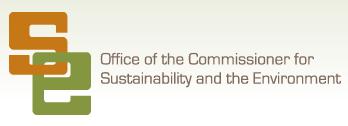
So this is where the tax revenue of the people of Australia’s Capital Territory around Canberra is being spent. How much did this report cost? How much did the OCSE logo above cost – took a lot of imagination that one!
Tags: ACT bureaucracy, ACT Commissioner for Sustainability and the Environment, ACT taxpayers money wasted, Dr Maxine Cooper, Eastern Broadacre, Eastern Grey Kangaroos, Environment and Sustainable Development Directorate, greenwash, kangaroo meat, kangaroo pet food, kangaroo slaughter, Report of the Grassland Forum, save the kangaroo, the biased leading the inept, Visit Canberra
Posted in Kangaroos and Macropods, Threats from Poaching and Poisoning | No Comments »
Add this post to Del.icio.us - Digg
Friday, August 26th, 2011
 Who does one believe?… Who does one believe?…
Greenwash Tick
.
.
.
Tuesday 23-Aug-2011:
‘Paper manufacturer loses green credentials’
by Liz Hobday, ABC News, 20110823, ^http://www.abc.net.au/news/2011-08-23/paper-manufacturer-loses-green-credentials/2851982/?site=melbourne, accessed 20110825]
.
The Wilderness Society says Australian Paper cannot meet environmental standards. The manufacturer of Reflex paper has lost part of its international environmental certification, after withdrawing from an audit of its wood supplies.

The Forest Stewardship Council was auditing Australian Paper, to check that the wood used to make Reflex paper is not sourced from high conservation value forests.
Luke Chamberlain from the Wilderness Society says the company withdrew from the process, because it cannot meet environmental standards.
“The makers of Reflex paper get their wood from the Victorian State Government native forest logging arm VicForests,” he said.
 “VicForests log in endangered species habitat. They log old growth forests in East Gippsland and the central highlands” “VicForests log in endangered species habitat. They log old growth forests in East Gippsland and the central highlands”
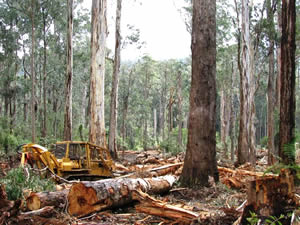
Australian Paper says its products are not sourced from high conservations value forests threatened by logging.
Shaun Scallan from Australian Paper says they withdrew because the audit process changed while it was underway.
“We pulled out because of a change in the definition of part of the standard late in the piece, which did not allow us enough time to then satisfy that changed definition,” he said.
.
.
Meanwhile the same Shaun Scallan of Australian Paper just the day prior on Monday 22 August 2011 posts his media release:
.
‘Australian Paper retains FSC Chain of Custody Certification’…?
by Shaun Scallan, Australian Paper, 20110822, ^http://australianpaper.com.au/media/2478/AP%20FSC%20audit%20release%20FINAL%20Aug%2022_2011.pdf, accessed 20110825
.
‘Australian Paper has successfully retained Forest Stewardship Council (FSC) Chain of Custody certification (FSC-C002059) in its latest audit. Auditor Rainforest Alliance confirmed that under the certification Australian Paper may continue to produce FSC-certified product based on sourcing of material from FSC-certified operations and recycled content, as allowed under the FSC rules for Mixed and Recycled product.
.
“We are pleased to have retained our FSC Chain of Custody certification,” Australian Paper CEO Mr Jim Henneberry said.
“Australian Paper has held Chain of Custody certification since 2006. However, we have decided to remove the Controlled Wood component from our certification at this time as there has been uncertainty around the interpretation of key elements of the standards.”
.
“Advice received by Rainforest Alliance from FSC International around the interpretation of the Standard was received after the physical audit had been completed. This left insufficient time for us to address and so we elected to withdraw Controlled Wood from our certification.” Mr Henneberry said.
.
Australian Paper remains committed to ensuring that fibre supplies come from internationally recognised, third party certified sources and also regards the Australian Forestry Standard and PEFC as benchmark certifications under this policy. The majority of wood supplied to Australian Paper is certified to the Australian Forestry Standard.
.
“We are also continuing to consult with a wide range of stakeholders as part of our Future Fibre Strategy review,” Mr Henneberry said.
“It is vital that we achieve the best balance between the environment, the health of regional communities and our ongoing competitiveness. We look forward to sharing outcomes from this review in due course.”
.
.
Meanwhile, we have the boss of Nippon Paper (the Japanese company that owns the misnomer ‘Australian Paper’) declaring Nippon Paper is going gang-busters to become a top global pulp and paper company…(at any cost?)
 ‘Since I was appointed president of Nippon Paper Group, Inc. in 2008, I have been pursuing “growth-oriented management.” This means exploring every possibility with a consistently positive stance, actively seizing opportunities, achieving the growth needed to become one of the top pulp and paper companies worldwide, as set out in the Group Vision 2015, and developing corporate value that meets the expectations of all stakeholders.’ ~ President of Nippon Paper Group, Yoshio Haga. [Source: ^http://www.np-g.com/e/about/president.html] ‘Since I was appointed president of Nippon Paper Group, Inc. in 2008, I have been pursuing “growth-oriented management.” This means exploring every possibility with a consistently positive stance, actively seizing opportunities, achieving the growth needed to become one of the top pulp and paper companies worldwide, as set out in the Group Vision 2015, and developing corporate value that meets the expectations of all stakeholders.’ ~ President of Nippon Paper Group, Yoshio Haga. [Source: ^http://www.np-g.com/e/about/president.html]
 . .
.
Meanwhile, the stated Charter of Nippon Paper Group includes:
.
‘6. Active involvement with environmental issues assures that…’
.
- ‘We shall promote afforestation projects, to create and make effective use of sustainable forest resources.’
- ‘We shall promote energy conservation, the use of wastepaper and other measures to effectively use resources that are limited in quantity.’
- ‘We shall manage and reduce all types of discharge and waste generated in the course of corporate activities.’
- ‘We shall research and develop manufacturing technologies, and products and services that are in harmony with the environment.’
.
[Source: ^http://www.np-g.com/e/about/charter.html#shead2]
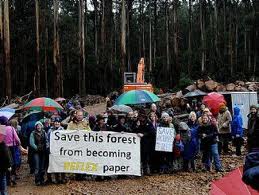
Editor: It is suspicious when a Japanese company is more than content to log and irrevocably destroy another country’s old growth forests, while Japan’s own old growth forests around Mt Fuji remain sacrosanct.
‘In spite of the abundant natural resources, logging is not commonly practiced in the forests of Japan. Japan Forests are venerated and protected since they provide essential soil cover and help in water conservation. All Species are encouraged to grow in the Forests in Japan , from the broad-leaved deciduous to the evergreen coniferous types. There are also many forests which grow near volcanic areas, destroyed and then rejuvenated every time an eruption occurs. The Aokigahara Forest at the base of Mount Fuji is one such forest. Locals as well as tourist camp, trek and hike through these dense forests of Japan to explore their unusual natural beauty.
‘Some Japan Forests are designated as Sacred Forests . These forests generally contain an ancient religious Shrine, usually worshiping the Shinto religion and are protected from trespassing and destruction. These forest shrines are still venerated as national treasures.
.
Some of the sacred forests in Japan are-
- The Forest of the Yahiko Jinja has many trees like the Cedar, Cypress and Oaks. The Shrine has a sacred Chinquapin tree as well.
- The Forest of Atsuta Jinja is an important Shinto Shrine, housing one the three important Shinto relics – the holy sword of Kusanagi-no-tsurugi. The forest has evergreens like the Japanese Camellia Sakaki, camphor trees, Ilex and Japanese Honeysuckle.
- The Forest of Kashima Jingu has over 800 species of trees like varieties of Cedar, Fir and Oak. The Kashima Jingu is an important shrine of the Kanto Area. The forest has been designated as a Wildlife Protection area for the rare birds in the region.
- The Forest of Shimogamo Jinja covers over 495 hectares and has many different species of deciduous trees like the Zelkova, the Elm and the Hackberry. The Shrine itself has 53 buildings which have been designated as National Heritage Architecture.
- The Forest of the Kirishima Jingu covers and area of 887 hectares. Located near the Mount Kirishima Volcano, the forest has been destroyed and then recovered for over 60 times.
- The Forest of the Kasuga Taisha is home to the beautiful podocarpus Nagi. The forest also contains many species of evergreens and shrubs. Trees like the Kasuga, the Andromeda and the Ichii also grow there. People from all over Japan visit the venerated shrine in the quarterly pilgrimages.‘
[Source: ^http://www.mapsofworld.com/japan/japan-tourism/forests-in-japan.html]
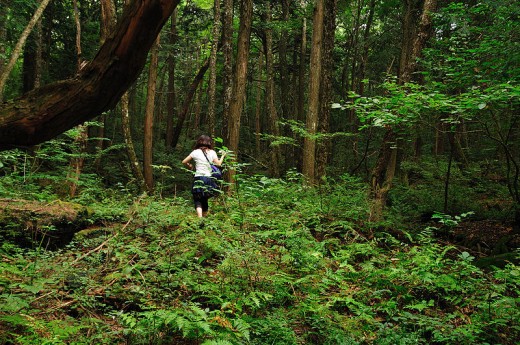 Japan’s sacred Aokigahara Forest Japan’s sacred Aokigahara Forest
.
Ethics question for Yoshio Haga (President of Nippon Paper Group):
What moral right do the Japanese have to consider their own native old growth Aokigahara Forest more sacred than Australia’s sacred native old growth forests such as those across East Gippland?
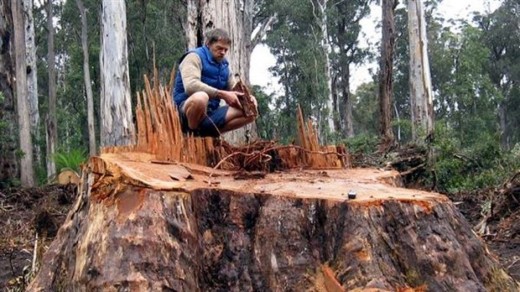 Stump of Brown Mountain’s sacred 600 year old Mountain Ash old growth tree.
It was logged by VicForests in November 2008 for Nippon Paper’s Reflex Paper. Stump of Brown Mountain’s sacred 600 year old Mountain Ash old growth tree.
It was logged by VicForests in November 2008 for Nippon Paper’s Reflex Paper.
.
.
In light of VicForests recent civil prosecution in the Victorian Supreme Court, Nippon Paper Group’s association with VicForests calls into question the reputation of Nippon Paper Group and its brand Reflex Paper:
.
‘VicForests has been stopped from harvesting certain coupes in the Brown Mountain forest in East Gippsland containing old growth forest
– habitat for rare and threatened species – until the completion of steps implementing the precautionary principle.’
.
.
.
‘Environment East Gippsland Inc v VicForests – The precautionary principle in action’
22 November 2010:
[Source: Blake Dawson (Lawyers), ‘Environment Matters’, 20111122, ^http://www.blakedawson.com/Templates/Publications/x_article_content_page.aspx?id=60457, accessed 20110825]
.
.
In Brief:.
- ‘The Victorian Supreme Court decision in Environment East Gippsland Inc v VicForests firmly embeds the approach to the precautionary principle laid down in Telstra Corporation Limited v Hornsby Shire Council (2006).’
- ‘The case makes it clear that the precautionary principle can be the subject of an enforceable obligation.’
- ‘The case also makes it clear that the precautionary principle applies both at the strategic and operational stages of a project or undertaking.’
- ‘The fact that VicForests complied with its forestry approvals was not enough to satisfy the Court that it had met its obligations with regard to the precautionary principle.’
.
‘In Environment East Gippsland Inc v VicForests [2010] VSC 335 conservation group Environment East Gippsland (EEG) won a landmark injunction against VicForests, a state-owned timber business with responsibility for commercial timber harvesting in Victoria’s state forests.
VicForests has been stopped from harvesting certain coupes in the Brown Mountain forest in East Gippsland containing old growth forest – habitat for rare and threatened species – until the completion of steps implementing the precautionary principle.
In this case, Justice Osborn of the Supreme Court of Victoria undertook a thorough analysis of the application of the precautionary principle in the context of a detailed legislative regime aimed at balancing biodiversity protection and commercial timber harvesting. The case embeds the approach to the precautionary principle laid down by Chief Justice Preston of the Land and Environment Court of New South Wales, in Telstra Corporation Limited v Hornsby Shire Council (2006) 67 NSWLR 256.’
.
The lead-up to the litigation
.
‘The Brown Mountain forests in Victoria’s East Gippsland contain old growth forests and provide habitat for rare and threatened species such as the Powerful Owl, the Spotted-tailed Quoll (mainland Australia’s largest marsupial carnivore) and the Long-footed Potoroo. However, these areas are also amongst the most productive timber harvesting forests in Victoria and play a crucial role in Victoria’s sustainable timber industry.
In 2006, the Victorian State Government committed to increasing the conservation parks and reserves within the broader Brown Mountain area. Nevertheless, in 2008 commercial logging in the Brown Mountain area began.
After numerous studies of the area indicated the presence of important threatened and rare species, EEG requested the Minister for Environment and Climate Change, Gavin Jennings, to make an interim conservation order to conserve critical habitat of the endangered Long-footed Potoroo, Spot-tailed Quoll, Sooty Owl, Powerful Owl and Orbost Spiny Crayfish at Brown Mountain. The Minister did not grant a conservation order, but instead increased the conservation area surrounding Brown Mountain.
Having failed to obtain undertakings from VicForests that it would not proceed to log the Brown Mountain coupes, EEG sought interlocutory injunctive relief. An interlocutory injunction restraining logging was granted by Justice Forrest on 14 September 2009 (see our article Environmental litigation heats up with some significant wins for public interest litigants in our 2 October 2010 edition of Environment Matters ), pending the outcome of the full proceedings before Justice Osborn in the Supreme Court of Victoria.’
.
The legislative regime
.
‘Logging of state forests in Victoria is regulated by a complex scheme of legislation, codes of practice, management plans and procedures, described by Osborn J as “labyrinthine”. The principal legislation includes the Forests Act 1958 (Vic) (Forests Act), Sustainable Forests (Timber) Act 2004 (Vic) (SFT Act), Flora and Fauna Guarantee Act 1988 (Vic) and Conservation, Forests and Lands Act 1987 (Vic).’
.
Responsibilities for timber harvesting and forestry management
.
‘VicForests is a state-owned corporation, established in 2004 to undertake the harvesting of timber in Victoria’s state forests. The Secretary to the Department of Sustainability and Environment (DSE) has overarching responsibility for managing state forests and timber harvesting within forests under the Forests Act.’
.
Legal challenge
.
‘EEG sought an injunction restraining VicForests from harvesting four coupes at Brown Mountain containing old growth forest. It also sought declarations that timber harvesting within the coupes by VicForests in accordance with the current forestry regime would be unlawful.
EEG argued that the current conservation measures for the Brown Mountain coupes did not meet the requirements of the regulatory system, which addresses the preservation of conservation values and in particular the protection of endangered species. EEG also argued that VicForests had failed to implement the precautionary principle.
VicForests took issue with EEG’s standing to sue. Further, it denied the presence of a number of endangered species and argued that the logging of the Brown Mountain coupes would take place under a legislative framework that adequately protects endangered species and would, therefore, be lawful. It also argued that it was DSE’s responsibility to stipulate any further requirements for habitat protection in accordance with the regulatory regime.’
.
EEG’s standing
.
‘Following the settled High Court authority that standing to bring such proceedings depends on the plaintiff’s “special interest” in the subject matter of the litigation (Australian Conservation Foundation v Commonwealth (2000) 200 CLR 591), Osborn J was satisfied that EEG had a relevant “special interest” because:
- EEG uses the coupes to a greater degree than the general public (for example, the group has a “Valley of the Giants Old Growth Forests Walk” through the affected coupes);
- EEG’s predecessor was involved in the consultative process for the formulation of the applicable forest management plan; and
- the government has previously recognised EEG’s status as a body representing this sector of the public interest.’
.
The precautionary principle [Ed: once again]
.
‘The VicForests case firmly embeds in Australian environmental jurisprudence the approach to the precautionary principle laid down by Chief Justice Preston of the Land and Environment Court of New South Wales, in Telstra Corporation Limited v Hornsby Shire Council (2006) 67 NSWLR 256 (Telstra). Justice Osborn’s decision in VicForests is the first Supreme Court application of the Telstra principles.
The precautionary principle is integrated throughout the Victorian forestry regime’s many instruments.
Following Preston CJ’s two-fold test in Telstra, Osborn J stressed that the precautionary principle is a test of common sense. There must be:
- a threat of serious or irreversible environmental damage; and
- scientific uncertainty as to the environmental damage.
Justice Osborn stated:
Once both of these conditions or thresholds are satisfied, a precautionary measure may be taken to avert the anticipated threat of environmental damage, but it should be proportionate … [The] degree of precaution appropriate will depend on the combined effect of the seriousness of the threat and the degree of uncertainty.
It is a “wherever practicable” test.
In practice, this meant that once the two-fold test was satisfied by EEG, VicForests had the onus of proving that the threat posed by logging the coupes did not exist or was negligible. Because it could not do this, the question then became:
- whether the threat was able to be addressed by adaptive management measures (in this case the requirement for surveys and management zone reviews); and
- whether the measure alleged to be required (here the permanent injunction against logging the coupes) was proportionate to the threat in issue.
Justice Osborn carefully examined the legislative regime and held that it is not intended that VicForests only apply the precautionary principle at the strategic planning stage:
VicForests is specifically required to apply it [the precautionary principle] having regard to the results of monitoring and research as they come to light during operations. … The requirements of the precautionary principle fall to be considered in the light of the whole of the evidence bearing on these matters as it now is and not as it was at the time VicForests completed planning.
Justice Osborn stressed, however, that the precautionary principle sits within a wider statutory regime that takes into account principles of sustainable development.
He held that unless VicForests complied with the requirements of the applicable Flora and Fauna Guarantee Act Statements and with conditions stated in the relevant allocation order (under the Forests Act) and the Timber Release Plan (under the SFT Act), logging at Brown Mountain would be unlawful.
This meant that VicForests could not rely on its current approvals to log the coupes because DSE had not, for example, changed zonings in the coupes to reflect the presence of threatened species. VicForests had an ongoing, active duty to apply the precautionary principle, which included responding to new information as it became available.
Importantly, Osborn J stressed that the precautionary principle can be the subject of an enforceable obligation.’
.
Outcome
.
‘Justice Osborn ordered that VicForests stop harvesting until various measures had been completed to respond to the detection of endangered species and to implement a precautionary approach with respect to their potential extinction. The required measures included:
- creating or amending special management zones, special protection zones and retained habitat areas to protect the Long-footed Potoroo, Greater Gliders and Yellow-bellied Gliders (as relevant);
- undertaking further surveys for the Giant Burrowing Frog, Large Brown Tree Frog and Spotted-tailed Quoll; and
- completing a current review of the Powerful Owl and Sooty Owl Management Areas,
to the satisfaction of the Director, Biodiversity Policy and Programs, DSE.
The difficulty for the Court in formulating its orders was that the power to act on the evidence of rare and endangered species and implement the required legislative and policy changes lies not with VicForests, against whom the injunction was sought, but with DSE.
Justice Osborn overcame this difficulty by stopping VicForests from logging until certain actions are undertaken, these actions being DSE responsibilities. VicForests had maintained throughout proceedings that it would comply with any changes to the regulatory regime made by DSE, and this was accepted by the Court.
.
Significance of the decision
.
This case firmly embeds the approach to the precautionary principle laid down by Chief Justice Preston in Telstra Corporation Limited v Hornsby Shire Council (2006) 67 NSWLR 256.
Justice Osborn’s decision makes it clear that:
- The precautionary principle can be the subject of an enforceable obligation.
- Parties having an obligation to apply the precautionary principle cannot demonstrate compliance with the principle solely through departmental approval of their actions or relevant approvals under the regulatory regime; the precautionary principle is an active obligation that applies throughout operations, requiring parties to respond to new information as it arises.
- The precautionary principle applies throughout all stages of operation, not just the strategic planning (or approvals) stage.
The decision has broader implications because:
- The precautionary principle is embedded in many other statutory regimes in Victoria and around Australia, apart from the Victorian legislative regime for forestry and the protection of endangered species. The decision has implications for any statutory regime in which the principle is enshrined.
- Although VicForest is a state-owned enterprise operating within a highly regulated environment, there is scope for the decision to be applied to other types of entities operating within industries where the precautionary principle is relevant.
Furthermore, a decision of the Supreme Court of Victoria has strong precedent value, and is likely to be adopted by the Supreme Courts of other States, and perhaps even higher courts or courts with federal jurisdiction.
.
Action points
.
Parties under an obligation to apply the precautionary principle need to be aware that:
- to implement the precautionary principle as per the principles laid down in Telstra, parties need to ask:
- is there a real threat of serious or irreversible damage to the environment?
- if yes, is it attended by a lack of full scientific certainty (in the sense of material uncertainty)?
- if yes, is the threat non-existent or negligible?
- if no, is the threat able to be addressed by adaptive management and is the measure alleged to be required proportionate to the threat in issue?
- the principle must be applied at both the strategic decision making stage of a project, and throughout the operational stage; and
- it may not be sufficient to simply obtain and comply with project approvals – parties need to proactively respond to new information as it arises throughout the operational stage.’
.
..
.
Further Reading:
.
[1] >Vicforests’ Ecological Genocide
.
[2] ‘Nippon buys Maryvale mill‘, by Ian McIlwraith, The Age newspaper, 20090217, ^http://www.theage.com.au/business/nippon-buys-maryvale-mill-20090216-89bu.html, accessed 20110826]
.
‘Paperlinx will take a $600 million hit on its half year results and the future of its Tasmanian operations is under review after last night unveiling the partial sale of its Australian papermaking business.
Japan’s Nippon Paper Group will buy most of Australian Paper, which includes the Maryvale pulp mill in Gippsland, for more than $700 million, including taking on attached debt and a three-year profit share agreement.
Money from the sale, expected to be completed in June, will go to reducing PaperlinX’s debt burden to about $340 million…’
[Editor: So Paperlinx was in debt to the Australian Tax Office by over a billion dollars? How can Australia’s pulp industry be profitable then?]
.
[3] Australian Paper Watch website (providing information about the logging of Victoria’s forests to make paper products such as Reflex by Nippon Paper and their ‘subsidiary’ Australian Paper), ^http://www.australianpaper.forests.org.au/
.
[4] Nippon Paper’s Maryvale Mill Upgrade, ^http://www.reflex.com.au/2008-Maryvale-Mill-Upgrade/
‘Australian Paper has a long history in the La Trobe Valley in Gippsland, Victoria, dating back to 1937 when established. Today, the Mill is Australia’s largest integrated pulp and paper operation. In response to global paper trends and changing consumer expectations for our products, Australian Paper (Nippon Paper subsidiary) embarked on a major upgrade of the Maryvale Pulp Mill in 2006 which was completed in December 2008. With an investment of $350 million, the upgrade significantly expanded the Mill’s production of bleached pulp capacity and delivered a range of safety, health and environmental benefits.’
.
[5] ‘Loggers, activists clash over forest‘, by Adam Morton, The Age newspaper, 20110817, August 17, 2011, ^http://www.theage.com.au/victoria/loggers-activists-clash-over-forest-20110816-1iwew.html
.
‘Conservationists have held up timber workers in a fiercely contested area of native forest on Melbourne’s fringe for nearly a month, chaining themselves to bulldozers and climbing trees scheduled for logging.
The protest, which has led to at least 10 arrests, is expected to reach a climax today as activists and local residents march into the logging coupe outside Toolangi in Victoria’s central highlands.
Protest organisers claim they have evidence the coupe is home to the endangered Leadbeaters Possum, which scientists say is under threat after Black Saturday bushfires wiped out up to half its habitat. But the Department of Sustainability and Environment says there has been no sign of live possums. Department spokeswoman Kim Payne said one tree in the coupe had hollows that showed evidence of possum use. That tree would be left standing, but the coupe did not meet the legal criteria of prime possum habitat and could otherwise be logged.
Sarah Rees, director of Healesville-based group My Environment, said it was cruel to think a possum could be protected by retaining a single tree while taking away the forest around it. She said logging was hurting central highlands communities.
.
”Tourism based on the state forest is far more important to the local economy than forestry and the two cannot co-exist,” she said.
The conflict over the Toolangi State Forest was the focus of a public meeting in the area late last week when logging opponents verbally clashed with forestry workers, who accused the activists of restraint of trade. One contractor said he had lost about $80,000 due to the protests.
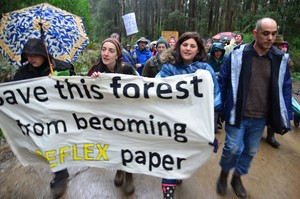
David Walsh, spokesman for state commercial timber agency VicForests, said the Toolangi protests had cost forest workers significant time. Only about a quarter of the 19-hectare coupe had been harvested. He said gates raised to ensure public safety had been damaged. ”VicForests believes these are legal harvesting operations which comply with the detailed legislative framework governing native timber harvesting in Victoria,” he said.‘
.
Editor: The legal doctrine of ‘restraint of trade’ sought to be applied in the commercial exploitation and destruction of old growth forests, is an invalid excuse. It is a contemptible euphemism for a ‘right to rape’ old growth ecology that is being contrived by commercial lawyers profiting from the exploiters ~ a case of the morally bankrupt collaborating with the damned.
[6] Ethical Paper website, ^http://www.ethicalpaper.com.au/
.
[7] My Environment website, ^http://www.myenvironment.net.au/
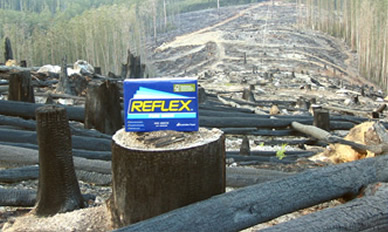
.
– end of article –
Tags: Aokigahara Forest, Atsuta Jinja, Australian Forestry Standard, Australian Paper, Chain of Custody certification, deforestation, East Gippsland, EEG, endangered species habitat, Environment East Gippsland, Environment East Gippsland Inc v VicForests, Flora and Fauna Guarantee Act, Forest Stewardship Council, Forestry Standard Certification, FSC, FSC audit process, FSC Chain of Custody Certification, FSC International, FSC-C002059, Future Fibre Strategy, Giant Burrowing Frog, Greater Glider, Greenwash Tick, Kashima Jingu, Kasuga Taisha, Kirishima Jingu, Large Brown Tree Frog, Leadbeaters Possum, Logging, Long-footed Potoroo, Maryvale Pulp Mil, My Environment, Nippon Paper Group, PEFC, Powerful Owl, precautionary principle, pulp and paper, Rainforest Alliance, Reflex Paper, restraint of trade, right to rape, sacred forest, Shimogamo Jinja, Shinto religion, Sooty Owl, The Wilderness Society, Timber Release Plan, Toolangi State Forest, TWS, VicForests, Yahiko Jinja, Yellow-bellied Glider
Posted in Gippsland (AU), Owls, Potoroos, Quolls, Reptiles, Threats from Deforestation | No Comments »
Add this post to Del.icio.us - Digg
Thursday, August 25th, 2011
 The Great Grey Owl of Lapland (Strix nebulosa) – the largest owl in existence
(click to enlarge) The Great Grey Owl of Lapland (Strix nebulosa) – the largest owl in existence
(click to enlarge)
.
‘A little knowledge is a dangerous thing‘ is a wise old proverb meaning that a small amount of knowledge can mislead people into thinking that they are more expert than they really are.
The phrase is considered originally derived from English politician and philosopher, Francis Bacon, in his literary work ‘The Essays: Of Atheism‘ of 1601, as follows:
.
“A little philosophy inclineth man’s mind to atheism; but depth in philosophy bringeth men’s minds about to religion.” [1]
.
It may generally apply quite aptly across the human species. Homo sapiens sapiens is the most intelligent species on the planet. Yet given our legacy thus far, are we really much more intelligent than any other species that exists simply to breed and perpetuate its species?
Our intelligence has enabled us to successfully breed not just for survival, but to colonise the planet like no other. Yet our intelligence can only be a little more intelligent than other species, since our breeding and colonisation has grown to such an extent that it has driven other species to extinction and has destroyed much of the planet upon which we depend. While other species have a symbiotic relationship with their environment, the extent of ecological destruction that humanity has caused and continues to cause to our host planet makes us Earth’s Pathogen. A pathogen is an agent causing disease or illness to its host, such as an organism or infectious particle capable of producing a disease in another organism. Human breeding and colonisation is extreme to the extent that it is approaching 7 billion. As we exponentially breed, colonise and destroy, we destroy our host planet.
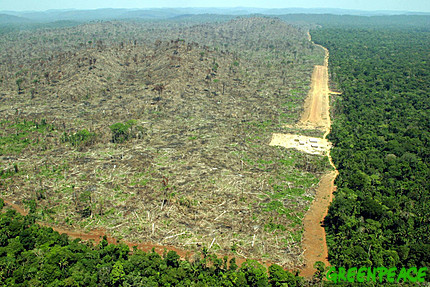
Speaking of religion, the demise and extinction of the Rapa Nui civilization on the remote Easter Island in the Pacific Ocean has become a metaphor for the self-destruction of humanity. One theory for the collapse of the Rapa Nui culture is that the Ancestor Cult that respected the dead drove the building of large stone statues (moai) to represent deified ancestors. It was believed that the living had a symbiotic relationship with the dead where the dead provided everything that the living needed (health, fertility of land and animals, fortune etc.) and the living through offerings provided the dead with a better place in the spirit world. The island’s trees were killed and used to help move these massive moai into desired position, but over time, as more moai were erected, the island’s trees were eliminated. Absolute deforestation led to the collapse of the island’s ecosystem and food supply and so to the demise of the Rapa Nui.
A second theory is that by Hunt and Lipo (2006) who found no evidence of human deforestation, or of human habitation prior to 1200. Instead, they suggest that the collapse of island society was due to the introduction of Polynesian Rats that arrived in the boats of early settlers. They hypothesize that rat population spiked at around 20 million individuals, and that these rats quickly consumed all the seeds of the native palms, leading to the collapse of the island food supply. [2]
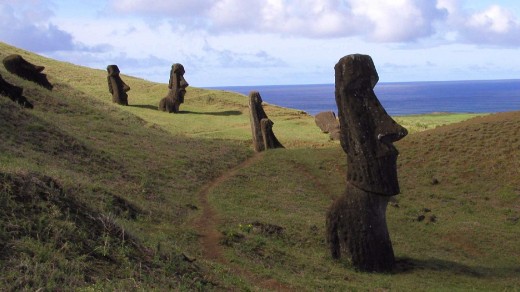 The Moai of Easter Island,
the living faces of worshipped ancestors of the Rapa Nui people
(click to enlarge) The Moai of Easter Island,
the living faces of worshipped ancestors of the Rapa Nui people
(click to enlarge)
.
.
‘Homo sapiens – time for a new name?
The following article is directly sourced from a transcript by Julian Cribb on the ABC Radio Science Show programme, which was aired 20110820 [3]
.
“It is high time the human race had a new name. The old one, Homo sapiens – wise or thinking man – has been around since 1758, and is no longer a fitting description for the creature we have become. When the Swedish father of taxonomy, Carl Linnaeus, first bestowed iti, humans no doubt seemed wise when compared with what scientists of the day knew about both people and other animals. We have since learned our behaviour is not quite as intelligent as we like to imagine, while some other animals are rather smart. In short, ours is a name which is both inaccurate and which promotes a dangerous self-delusion.
In a letter to Nature I am proposing there should be a worldwide discussion about the formal reclassification of humanity, involving both scientists and the public. The new name should reflect more truthfully the attributes and characteristics of the modern 21st century human, which are markedly different from those of 18th century ‘man’.
Consider the following: Humans are presently engaged in the greatest act of extermination of other species by a single species, probably since life on Earth began. We are destroying an estimated 30,000 species a year, a scale comparable to the greatest extinction catastrophes of the geological past.ii We currently contaminate the atmosphere with 30 billion tonnes of carbon equivalent every year.iii This risks an episode of accelerated planetary warming reaching 4-5 degrees by the end of this century and 8 degrees thereafter, a level which would severely disrupt food production.iv Estimates for the ultimate losses from 8of warming range from 50 to 90% of humanity.v
We have manufactured around 83,000 synthetic chemicalsvi, many of them toxic at some level, and some of which we inhale, ingest in food or water or absorb through the skin every day of our lives. A US study found newborn babies in that country are typically contaminated by around 200 industrial chemicals, including pesticides, dioxins and flame retardants.vii These chemicals are now found all over the planet, and we are adding hundreds of new ones, of unknown risk, every year. Yet we wonder why more people now die of cancer.
Every year we also release around 121 million tonnes of nitrogen, 10 million tonnes of phosphorus and 10 billion tonnes of CO2 into our rivers, lakes and oceans, many times the amounts recirculated by the Earth naturally. This is causing the collapse of marine and aquatic ecosystems, disrupting food chains and causing ‘dead zones’. More than 400 of these lifeless areas have been discovered in recent times.viii
We are presently losing about 1% of the world’s farming and grazing land every year. This has worsened steadily in the last 30 years, confronting us with the challenge of doubling food production in coming decades off a small fraction of today’s area. At the same time we waste a third of the world’s food.ix
Current freshwater demand from agriculture, cities and energy use will more than double by mid century, while resources in most countries – especially of groundwater – are drying up or becoming so polluted they are unusable.x
We passed peak fish in 2004xi, peak oil in 2006xii, and will encounter growing scarcities of other primary resources, including mineral nutrients, in coming decades. Yet demand for all resources, including food, minerals, energy and water, will more than double, especially in Asia.
Humanity spends $1.6 trillion a year on new weaponsxiii, but only $50 billion a year on better ways to produce food. Despite progress in arms reduction, the world still has around 20,000 nuclear warheads and at least 19 countries now have access to them or to the technology to make them.xiv
Finally, we are in the process of destroying a great many things which are real – soil, water, energy, resources, other species, our health – for the sake of a commodity that mostly exists in our imagination: money. While money has its uses as a medium for exchange, humanity is increasingly engaged in mass self-delusion as to what constitutes real wealth, as is quite clear from the current financial crisis.
All of these things carry the risk of catastrophic change to the Earth’s systems, making it difficult to justify our official sub-species name of Homo sapiens sapiens, or wise wise man. This not only looks like conceit, but sends a dangerous signal about our ability to manage what we have unleashed. A creature unable to control its own demands cannot be said to merit the descriptor ‘wise’. A creature which takes little account of the growing risks it runs through its behaviour can hardly be rated ‘thoughtful’.
The provisions of the International Code on Zoological Nomenclature provide for the re-naming of species in cases where scientific understanding of the species changes, or where it is necessary to correct an earlier error. I argue that both those situations now apply.
This is not just an issue for science; it concerns everybody. There needs to be worldwide public discussion about what is an appropriate name for our species, in the light of our present behaviour and attributes. Here are some names suggested by eminent Australian scientists. Marine scientist and author, Charlie Veron, suggests Homo finalis. Desert ecologist, Mark Stafford-Smith, proposes Homo quondam et futures – the once and future human. Spatial ecologist, Hugh Possingham, likes Homo nesciens – ignorant man. And atmospheric scientist, Barrie Pittock, suggests Homo sui deludens – self-deluding man.
Down the track we should not rule out an eventual return to the name Homo sapiens, provided we can demonstrate that we have earned it – and it is not mere flatulence, conceit or self-delusion. The wisdom to understand our real impact on the Earth and all life is the one we most need at this point in our history, in order to limit it. Now is the time humans get to earn, or lose forever, the title sapiens.”
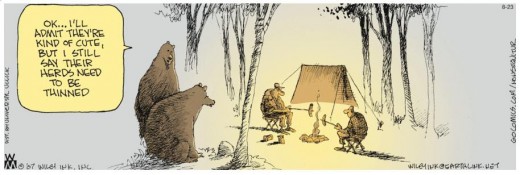 (Source: Non Sequitur – by Wiley Miller, ^http://www.gocomics.com/nonsequitur/2011/08/23) (Source: Non Sequitur – by Wiley Miller, ^http://www.gocomics.com/nonsequitur/2011/08/23)
.
.
Editor: Globally, a material difference between Humanity and other species is that we are more intelligent at doing what other species naturally do – colonising for our own self-interest. We are Homo colonus ventosa (the conceited coloniser), or simply Homo ego ruina (self-destructive Man).
If we accept that at our current stage of evolution we have a little more knowledge than other species; and that our legacy has proven thus far to be dangerous to us, other species and to the planet, then we would be wise to seek deeper knowledge of our circumstance, of our place and of other species and the planet. The test for Humanity now is to ask what would the wise do and not do? A first step in advancing our species is to recognise that we have become Earth’s Pathogen. the second step is to recognise that we don’t know the true extent of the damage we are causing to the planet and so in the face of such uncertainty, we are wise to adopt a precautionary approach. The Precautionary Principle states: ‘When an activity raises threats of harm to human health or the environment, precautionary measures should be taken even if some cause and effect relationships are not fully established scientifically. In this context the proponent of an activity, rather than the public, should bear the burden of proof. The process of applying the Precautionary Principle must be open, informed and democratic and must include potentially affected parties. It must also involve an examination of the full range of alternatives, including no action.’ [4]
.
‘We abuse land because we regard it as a commodity belonging to us. When we see land as a community to which we belong, we may begin to use it with love and respect.’
~Aldo Leopold, A Sand County Almanac (1949).
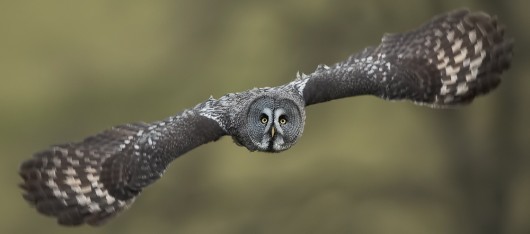 The Great Grey Owl in flight
(click to enlarge) The Great Grey Owl in flight
(click to enlarge)
.
.
References:
.
[1] ^ http://www.phrases.org.uk/meanings/a-little-knowledge-is-a-dangerous-thing.html
[2] Hunt, T. L.; Lipo, CP (2006). “Late Colonization of Easter Island”. Science 311 (5767): 1603
[3] ‘ Homo sapiens – time for a new name?‘, Julian Cribb, ^ http://www.abc.net.au/rn/scienceshow/stories/2011/3294576.htm, accessed 20110825
[4] Nancy Myers, 2004, ‘The Rise of the Precautionary Principle – A Social Movement Gathers Strength’ in  , September 2004, Vol. 25, No.9, http://multinationalmonitor.org/mm2004/09012004/september04corp1.html [> Read More]
.
– end of article –
Tags: a little knowledge is a dangerous thing, Aldo Leopold, Earth's Pathogen, Easter Island metaphor, Great Grey Owl, Homo sapiens sapiens, human pathogen, Rapa Nui
Posted in Owls, Ph05 Earth's Pathogen, Threats from Deforestation, Threats from Overpopulation | No Comments »
Add this post to Del.icio.us - Digg
|
|

 Uncontrolled speeding on Australian roads
Uncontrolled speeding on Australian roads
 Eira Battaglia, Mandy Beaumont, Niamh Kenny,
Cassie Thompson and Elvira Lanham at the damaged fence.
(Photo by Virginia Young)
Eira Battaglia, Mandy Beaumont, Niamh Kenny,
Cassie Thompson and Elvira Lanham at the damaged fence.
(Photo by Virginia Young)
 Wildlife Corridors do exist and are effective where human communities
care enough to insist on them.
But don’t expect road designers and engineers in Australia to suggest the concept.
Wildlife Corridors do exist and are effective where human communities
care enough to insist on them.
But don’t expect road designers and engineers in Australia to suggest the concept.



































































 ,
, 








